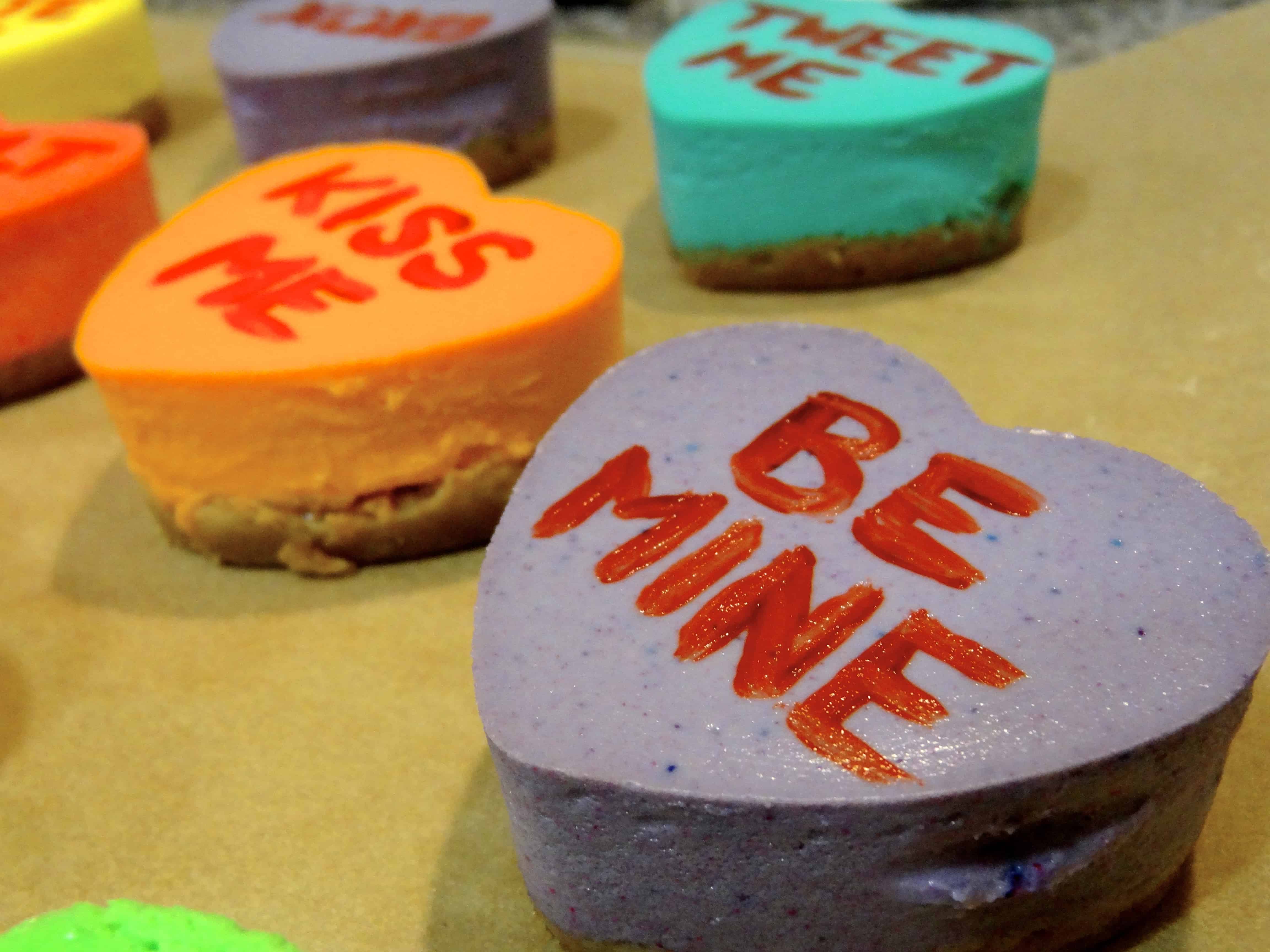
Kiss Me… Be Mine… Sexy… XOXO… Dreamy… Sweet Talk….. Text Me?!
I have to admit… I can’t stand Valentine’s Day conversation heart candies. To me, they are chalky and dry, and they just don’t taste good. However, those Sweethearts made by NECCO are one of the most iconic sweets for this holiday, and the quintessential choice for grade school valentines! I remember exchanging them clumsily with classmates, mumbling, “Happy Valentine’s Day…” to the kid who had just been mean to me on the playground… I always hated those little boxes with their crappy candies, cute and colorful as they were! Perhaps my distaste comes from this unpleasant childhood association, but despite this, for years I’ve been delighted by the many dessert tributes to the tiny hearts. Conversation heart cookies, cupcake toppers, and mini cakes abound on the internets! I’ve been wanting to try my hand at something like this for a few years, and as this is my first Valentine’s Day as a blogger, I finally decided this was the year it was going to happen! My favorite of all the things I’ve seen is heart-shaped mini cheesecakes, and I have to say that I’m utterly over the moon about these, both in taste and visual appeal.
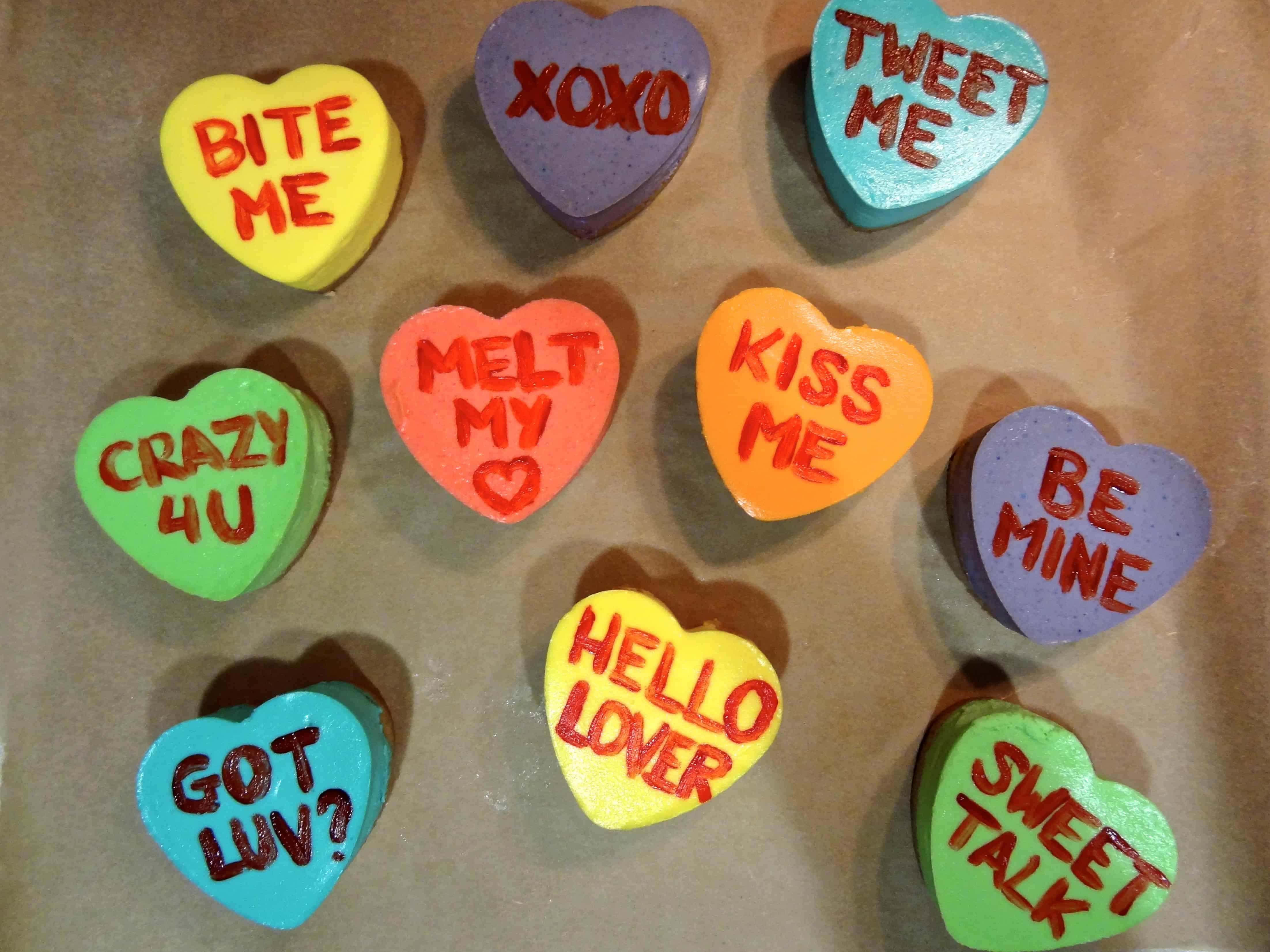
I saw several versions of these online, so I borrowed the decorating idea from Hungry Happenings (seems to be the source) and combined it with my favorite recipes. For the crust, there was zero question as to which recipe I would use: Momofuku Milk Bar’s Graham Crust. I can confidently say that I will never use any other graham cracker crust recipe ever again– it is that good. There are two ingredients in it that are not typically found in your run-of-the-mill crust recipe: heavy cream and milk powder, both of the which elevate this graham crust to milky, ethereal heights. (I’ve been known to make a batch of this crust with no intention of using it as, well, a crust— all I need is my trusty fork… ;-))
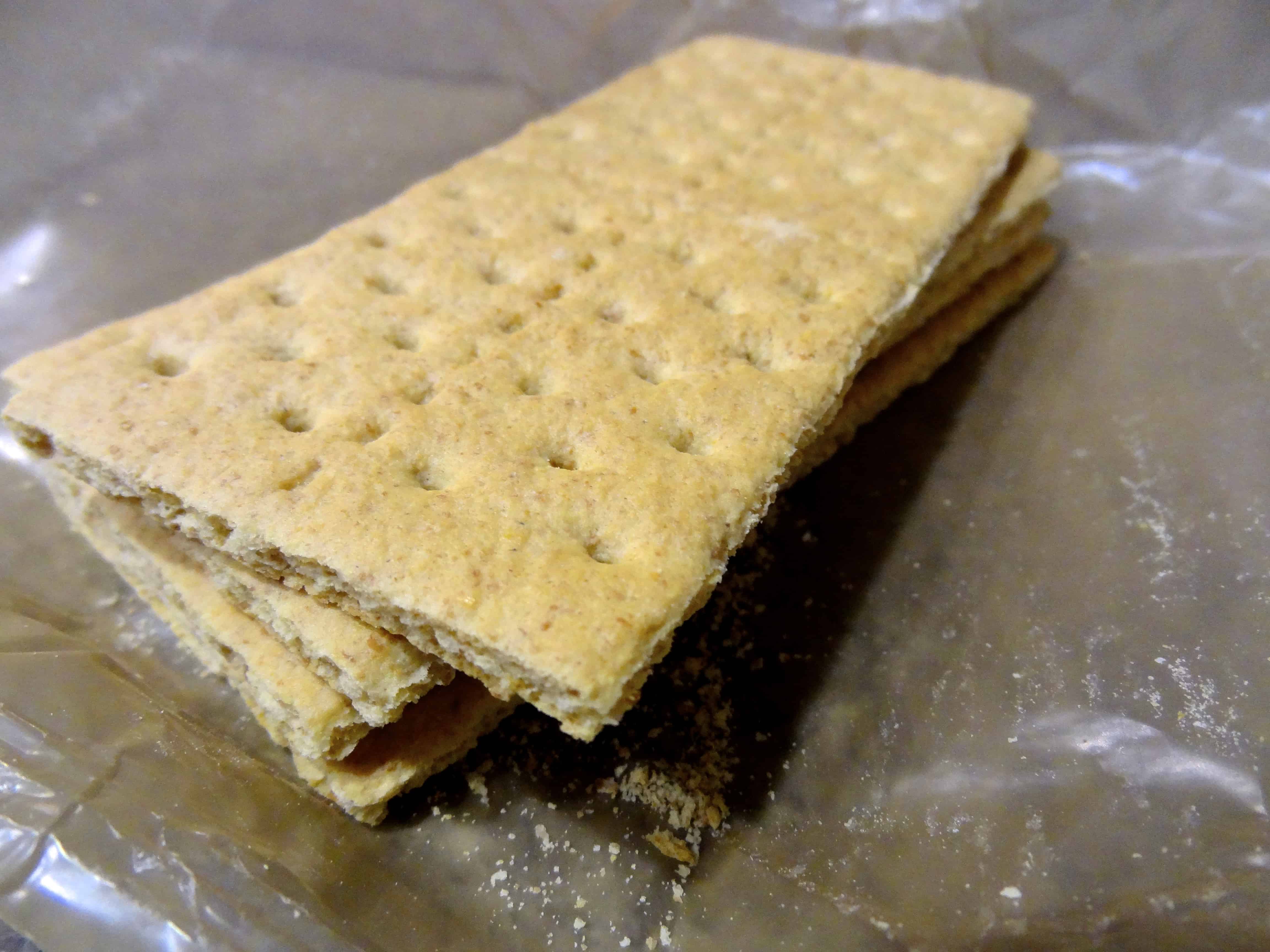
As for the cheesecake filling, I used a recipe from the Food Network by Chef Nick Malgieri. The texture is extra smooth and creamy due to the addition of sour cream, and it’s very easy to pull together. I made some slight adjustments (bumped up the vanilla and increased mixing speeds), but it’s still pretty true to the original. Incidentally, if using this recipe for any other purpose, I would use actual vanilla beans or vanilla bean paste because I like the speckled bean look and the intoxicating vanilla perfume imparted by both of these. However, because I wanted my cheesecakes to resemble candy hearts as closely as possible, I used the prescribed vanilla extract without visible beans.
One of the funnest parts of making these is deciding which phrases to put on the hearts. NECCO conversation hearts date back to 1901, and their sayings have evolved with the times; many of the classic ones, such as “Kiss Me” and “Be True”, are still being printed, but in the 1990’s, the company decided to update them with more modern phrases including “Call Me” and “Email Me”, and they continue to add new ones. Some of the most recent ones include “Tweet Me”, “Text Me”, “LOL”, and “Bieber Fever”. Okay okay, I made up the last one. For the cheesecakes, you can of course write whatever you want, so let your creativity take over. I added “Got Luv?”, “Hello Lover”, “Bite Me”, and just because I was feeling a little irreverent… “Frak Off”… 😉
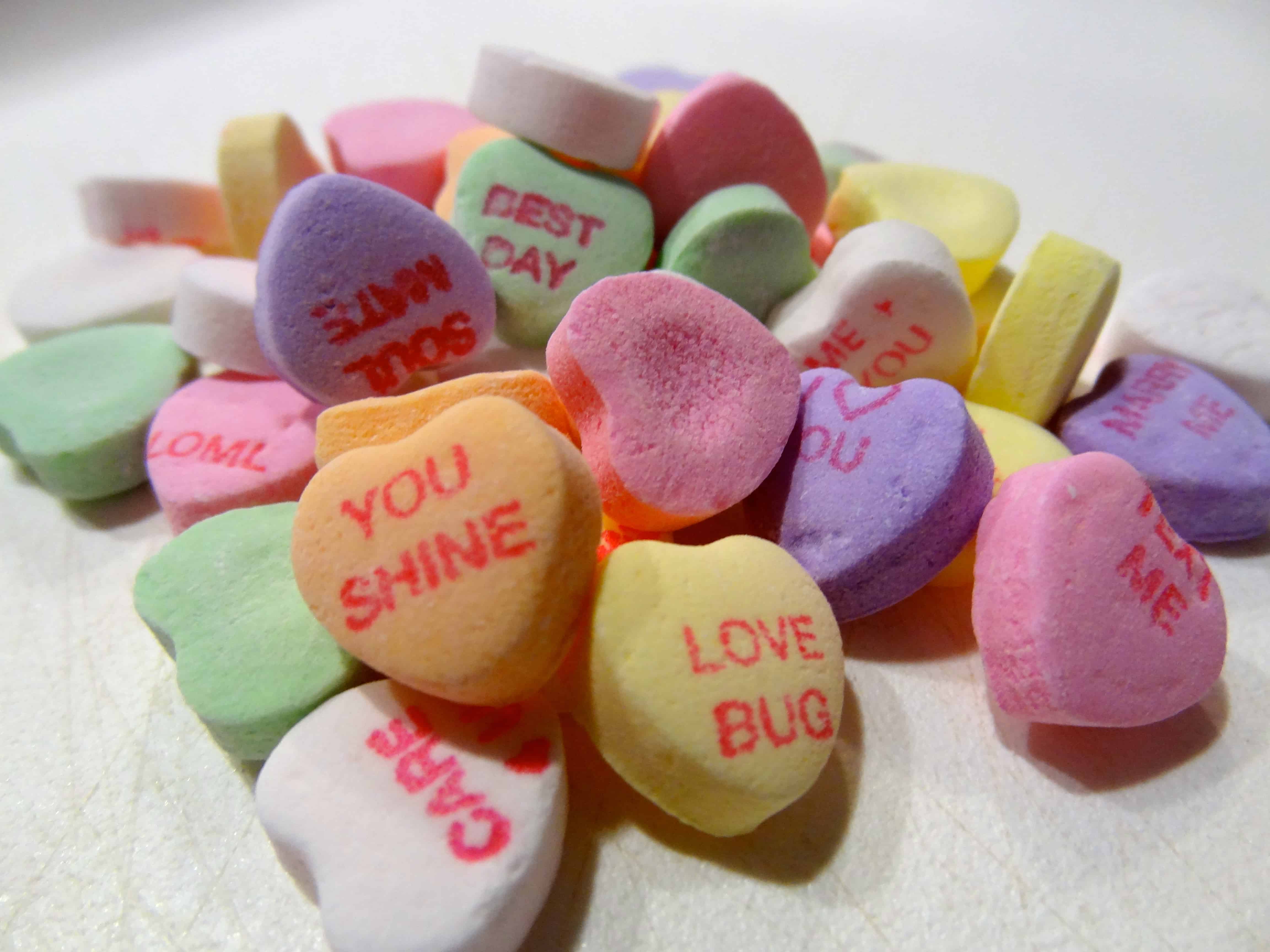
I don’t use silicone cake molds very often, as I find them awkward and hard to maneuver in and out of the oven. I considered using a heart-shaped mini cheesecake pan (the kind with removable bottoms in the wells so you can push the cakes straight up and out of the pan without destroying them), but those particular hearts weren’t quite the right heart shape. Though I am not generally a fan of Wilton products, the shape of the hearts in their silicone heart mold pan most closely resembled that of the Sweethearts candies, so I decided on this particular pan, despite my reluctance regarding silicone. I have to say that this mold was surprisingly sturdy compared to others I’ve used, and I definitely recommend it for this recipe if you want just the right heart shape. Each mold has 6 heart wells, and you will need 2 of them.
This recipe yields 12 mini cheesecakes when the wells are filled all the way to the top, and you will have some leftover batter, which you can use as desired. (I won’t judge if you just want to eat it with a spoon.) To make 18 smaller cakes, fill the heart wells about ¾ full, and you should have enough batter to fill a third silicone heart mold. I prefer the larger size, as they get a nice height when filled all the way up, and the directions below are geared toward a batch of 12.
The graham crust and cheesecake batter were both relatively quick and easy to make; the challenges that I experienced with this project were all about coloring the batter, managing the water bath, and removing the cakes from the silicone molds, and I definitely learned a few valuable lessons for next time!
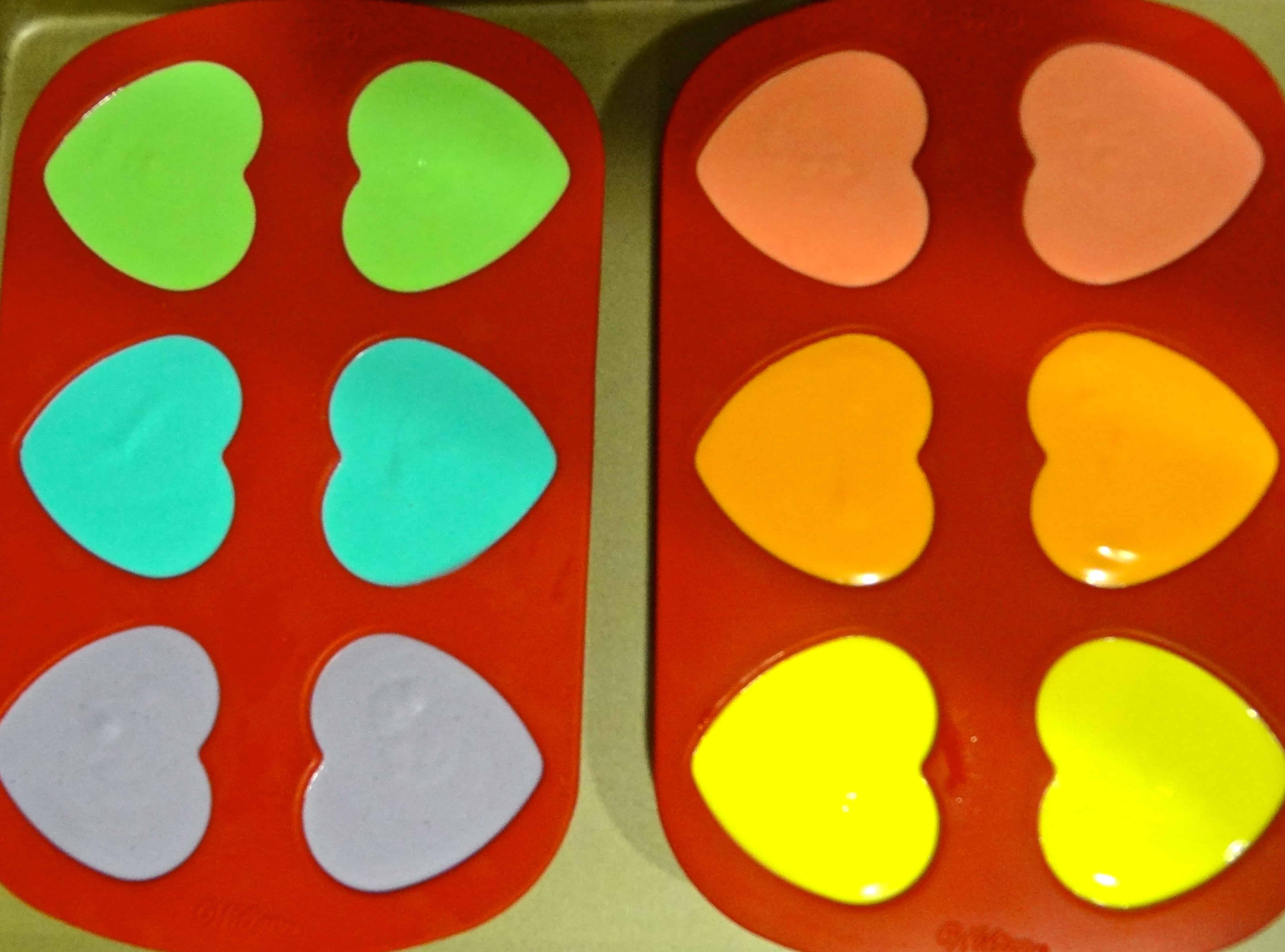
Notes about coloring your cakes:
- I strongly recommend using *gel* food coloring, not the liquid variety; the amounts listed here apply to gel only. I use Americolor brand, though there are others.
- Make sure your food coloring gels have not gone bad. I’ve had some of my bottles for years, and although they won’t kill anyone, a couple of the colors had gotten a bit congealed, which resulted in a less aesthetically pleasing “speckled” look when mixed into the cheesecake batter.
- When dying your batter in separate small bowls, I suggest leaving some extra plain batter aside in case you need to adjust the colors. The original directions call for 5-8 drops of each color, which was fine for certain colors (orange, yellow), but resulted in really dark shades for others. Fortunately, I hadn’t used all the batter, so I was able to add some of the extra to the darker colors to lighten them up a bit.
When transferring the cakes to and from the oven, keep safety in mind. The cheesecakes need to bake gently in a water bath so they don’t crack or dry out, but please, for the love of god, DO NOT do what I did. The original cheesecake recipe (which is for a full-sized cake) says to put the cake pan on a rimmed baking sheet and fill it with enough water to go halfway up the sides of said cake pan; the Hungry Happenings recipe recommends placing the silicone heart pans in a roasting pan filled with water. I don’t have a roasting pan big enough to fit both silicone molds, so I went with the sheet pan… I am extremely lucky that I didn’t burn both of my hands VERY badly. It is really hard to a) pull the sheet pan out of the oven without sloshing scalding water all over yourself, or b) grab and lift the silicone molds out of the sheet pan from the depths of the oven. I repeat, USE A ROASTING PAN, or two separate cake pans with high sides.
Taking the cakes out of the silicone molds was very tricky as well, though fortunately there was little to no risk of burning/injury/emergency room visits in this step! I tried to pop them out after removing the pans from the fridge, but the cakes were still too soft for this sort of manhandling, and I ended up destroying the first one.
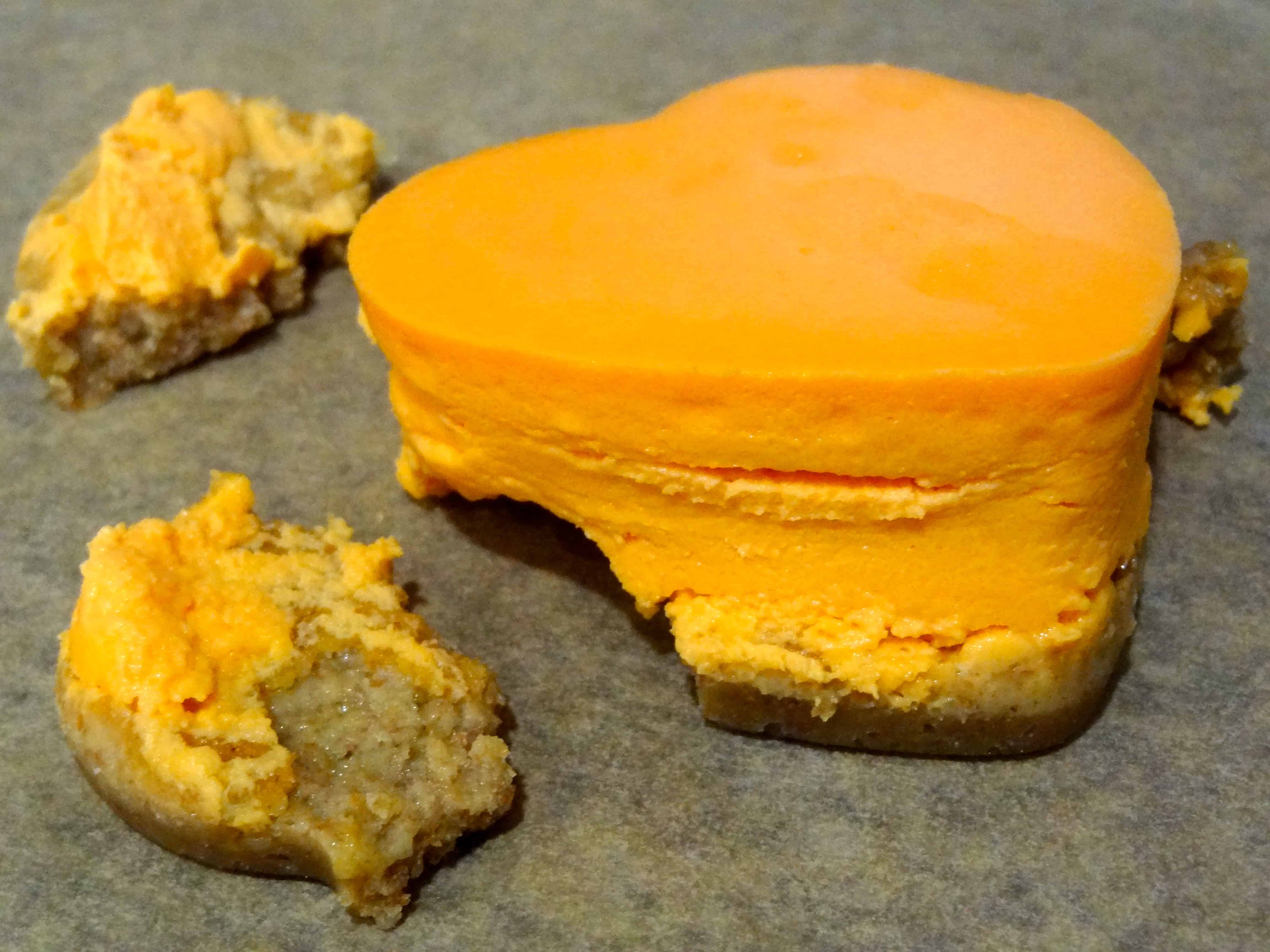
I then put them in the freezer for about 90 minutes to firm up, and this step was very helpful. Still, removing even the frozen cakes was a challenge, until I figured out the little trick explained below to release the “bond” between the crust and the silicone.
I have to say that I was so thrilled with these bright, charming little hearts. Most of the time, when I envision creating themed or decorated cakes, the image in my mind and the finished result look something like distant cousins at best… This time, I was so happy that my darlings came out just the way I had hoped, though my letter-painting could use some practice… 😉
Baking is my favorite way to show my loved ones that I care, so Valentine’s desserts are super fun and special for me. I feel that these Sweetheart Cheesecakes are especially delightful, and they truly demonstrate the spirit of the holiday… I am, of course, referring to that whole “love” part, not the commercialization and over-saturation thrust upon us by Hallmark, Victoria’s Secret, and the like!
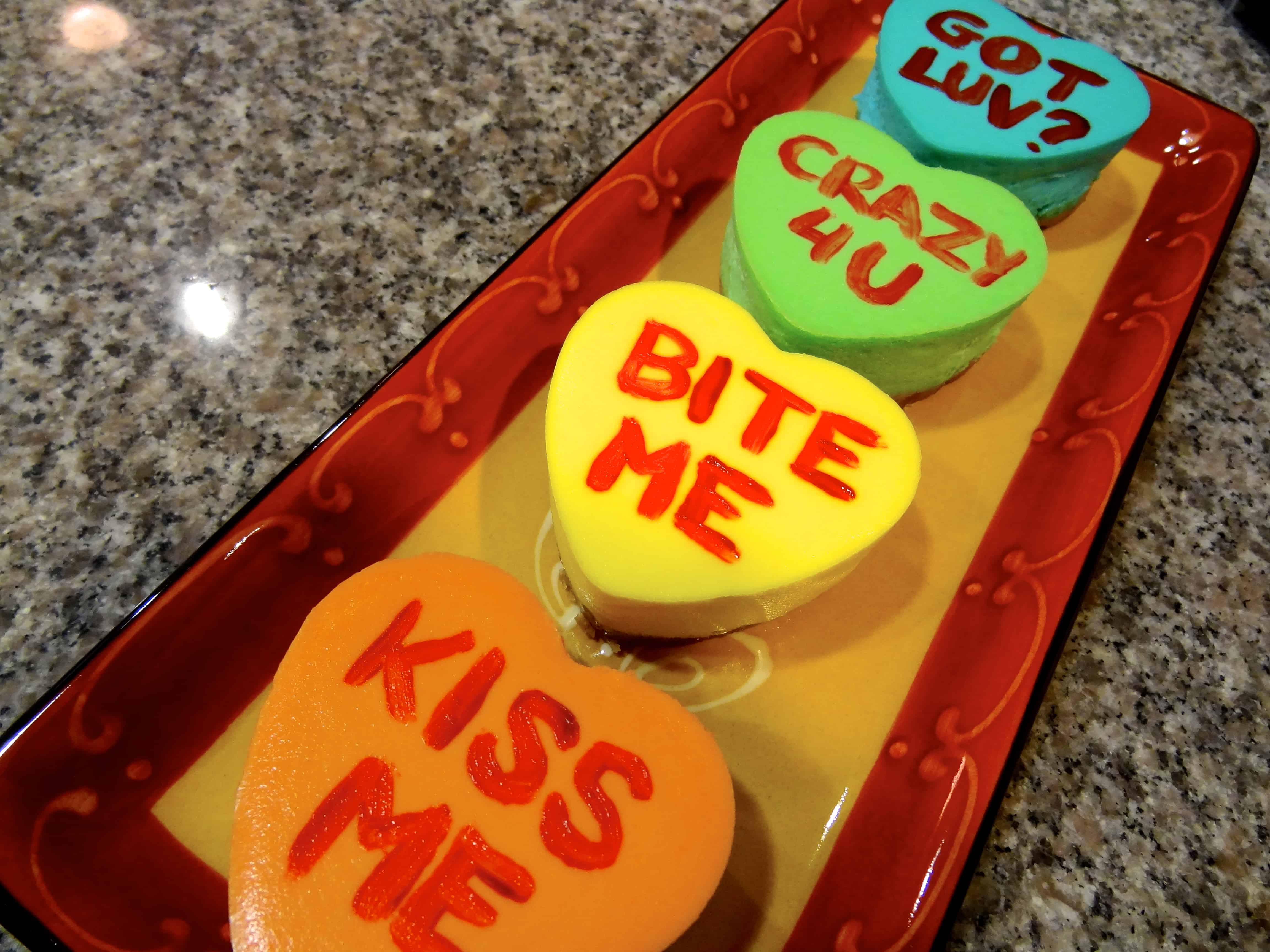
Valentine’s Sweetheart Cheesecakes
Artistic concept adapted from Hungry Happenings
Yields 12 mini cheesecakes, plus some extra batter
For crust (adapted from Momofuku Milk Bar cookbook):
- 1 recipe Graham Crust
For cheesecake batter (adapted from Food Network):
- 16 ounces (2 bricks) cream cheese, at room temperature (preferably Philadelphia brand)
- 1 cup granulated sugar
- 16 ounces (2 cups) sour cream
- 3 large eggs
- 2 ½ teaspoons pure vanilla extract (my favorite is Nielsen-Massey)
For decorating:
- 4 drops red gel food coloring
Equipment needed:
- 2 silicone cake molds with heart-shaped wells, preferably Wilton
- Roasting pan big enough to fit both silicone molds
- Fine-tipped paintbrush (used for food only)
Preheat an oven to 325°F and place a rack in the middle position. Rub the wells of your silicone heart pans with a very light coating of nonstick cooking spray; you don’t want them greasy– just enough to minimize sticking. Set aside.
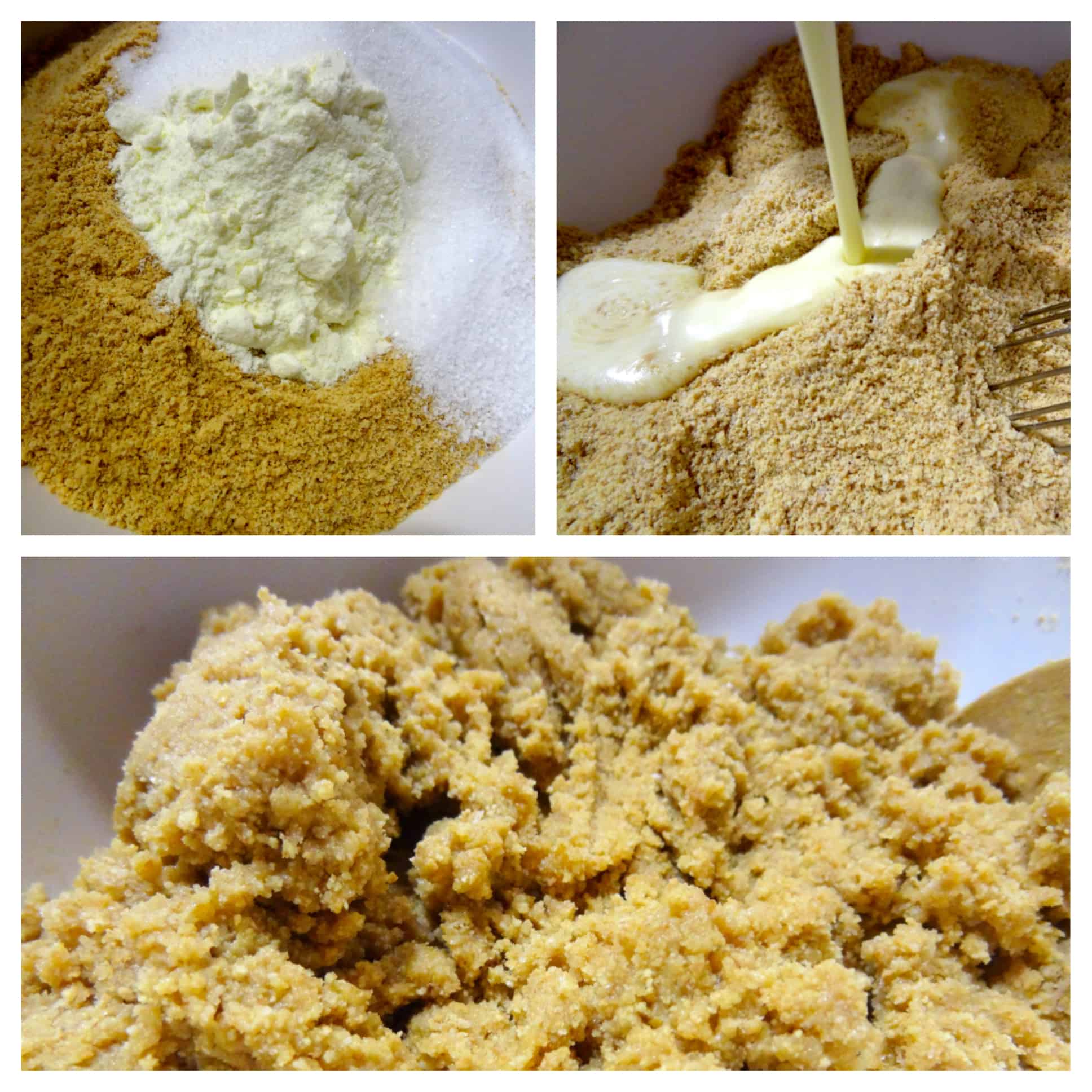
Prepare the graham cracker crust. One batch will yield more crust than you need, so you can decide how much you want to pack into the heart-shaped wells. (The vicious rumors about me making a double-batch just to eat the rest are NOT TRUE, I swear!) Spoon some crust into each well; I like a thick crust, about 1 centimeter high, so I used about 2 tablespoons per cheesecake, about 1 ½ cups total. (A thicker crust helps when unmolding the cakes later.) If you prefer a thinner crust, reduce to 1 tablespoon or so. Press the crumbs firmly into the bottom of each heart, to your desired thickness. Try to make them as level and even as possible, since the crusts will be visible when you unmold the cakes. Stick the silicone molds in the fridge while you make the cheesecake batter.
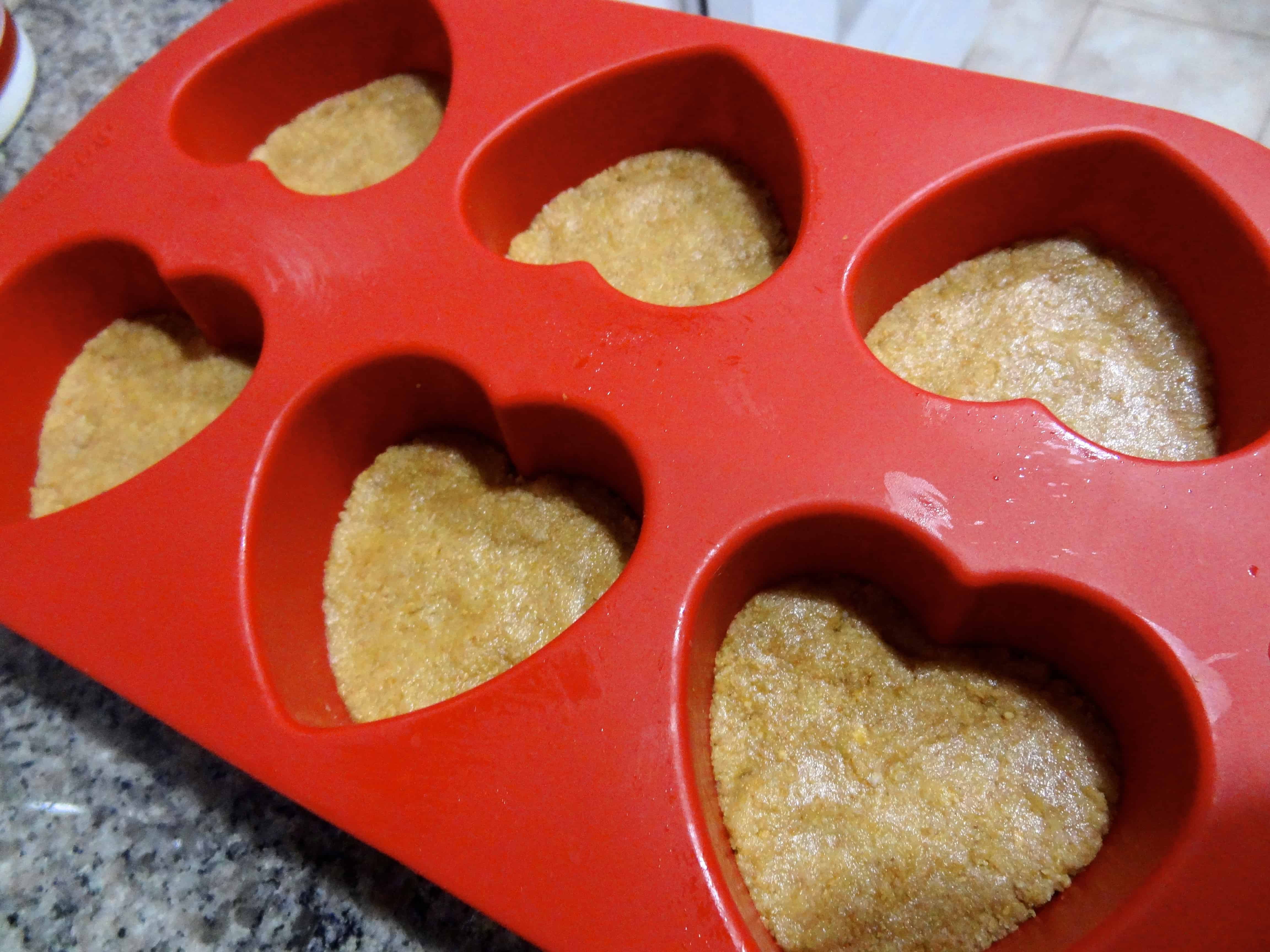
Place the cream cheese in the bowl of a stand mixer fitted with the paddle attachment and beat on medium-low speed just until smooth, about 30 seconds. Stop the mixer between each of the following additions, and scrape down the sides of the bowl and the beater as needed. Add the sugar in a stream, mixing for about 30 seconds. Add half of the sour cream and beat just until incorporated. Your batter will start to look looser and creamier. Add the rest of the sour cream and mix until incorporated. Add the eggs one at a time, mixing after each addition just until combined. Beat in the vanilla extract, scrape the bowl, and give the batter a quick whirl on medium speed to make sure everything is evenly mixed. The finished batter will be completely smooth and moderately thin in consistency.
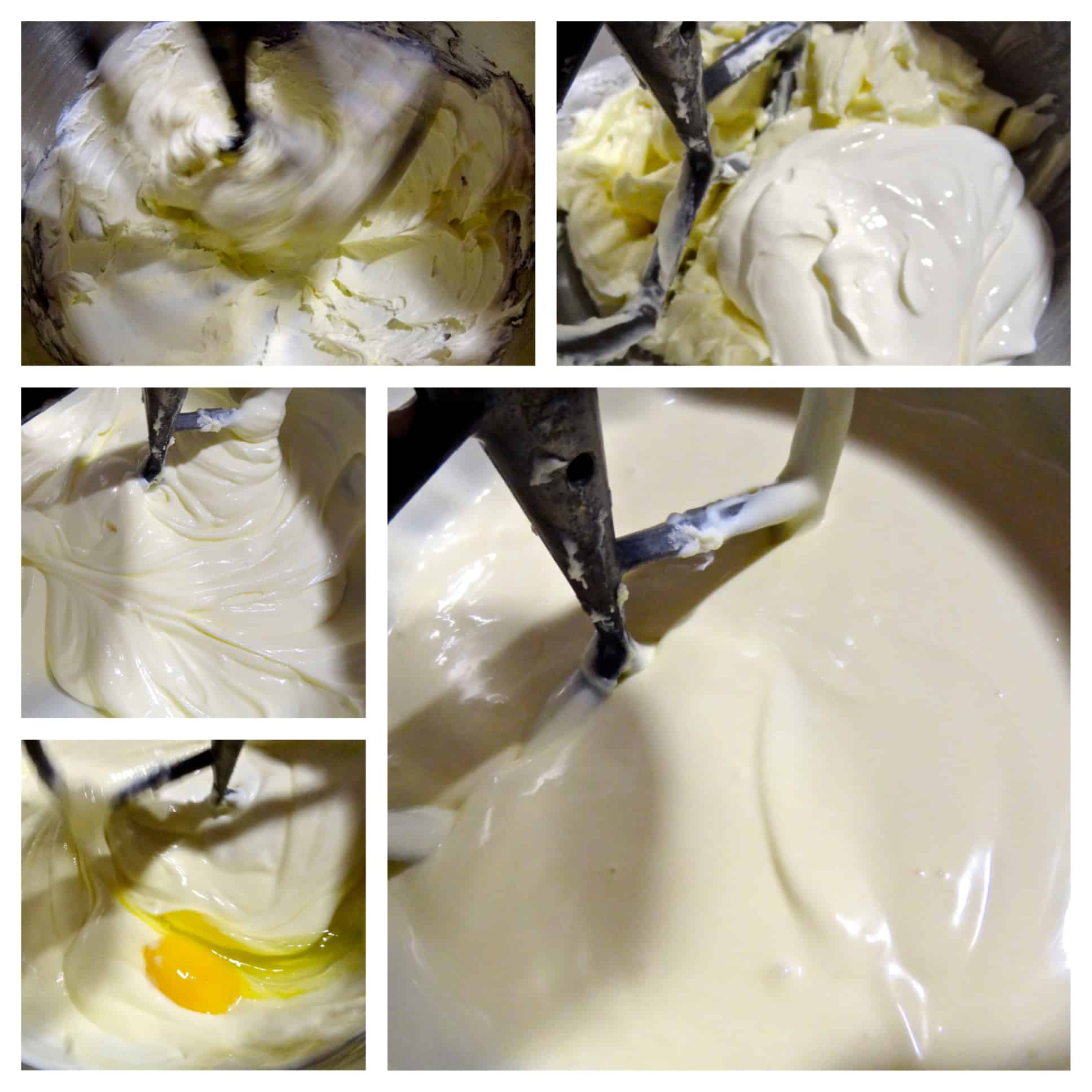
Divide the batter into 6 small bowls, reserving about 1 cup in case you need to adjust the colors after adding the food coloring. If you want to ensure even amounts in each bowl, use a spring-loaded ice cream scoop to measure and transfer the batter. (If you’re not quite as obsessive as me, you can eyeball it. ;-))
I used red, orange, yellow, green, blue, and purple to color my batter. Feel free to use the colors of your choice. Gel food coloring is highly concentrated, so I recommend starting conservatively to achieve your desired shades.
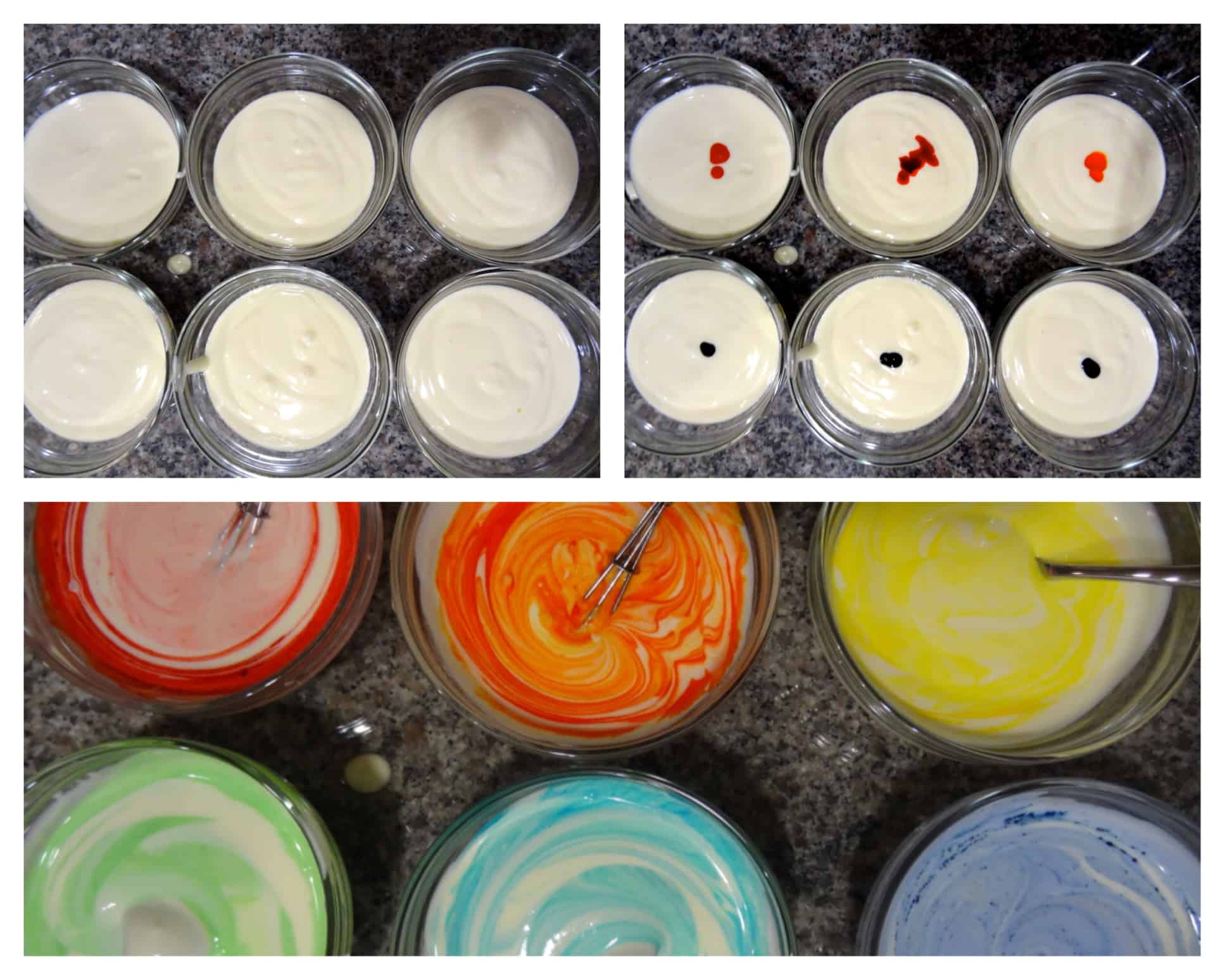
I initially put in about 5 drops of color in each bowl, which was fine for orange and yellow, but the darker colors came out much bolder than candy heart colors, so I added some of the leftover plain batter to dilute the color. I suggest starting with 3 drops for pastel colors, then add more gel color if you want a darker shade. Stir each batter with a small whisk or spoon until the colors are completely homogenous.
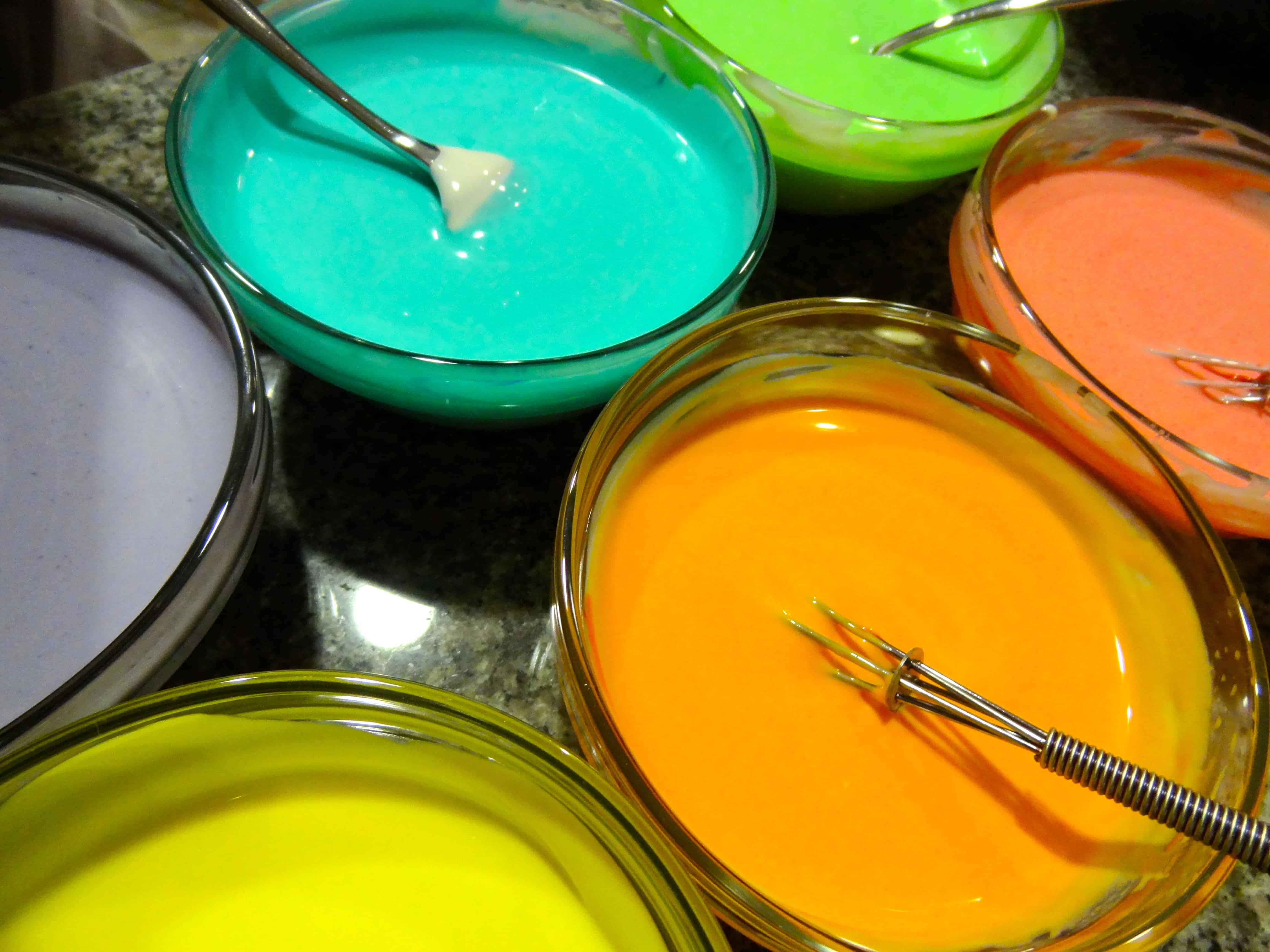
Once your 6 colors are mixed, retrieve the silicone molds from the fridge. You should have enough batter in each small bowl to fill 2 heart wells to the top, plus a little leftover of each color. Feel free to use the extra batter as desired: pour the batters into other molds, combine them to make one larger swirled cheesecake in a springform pan, etc.
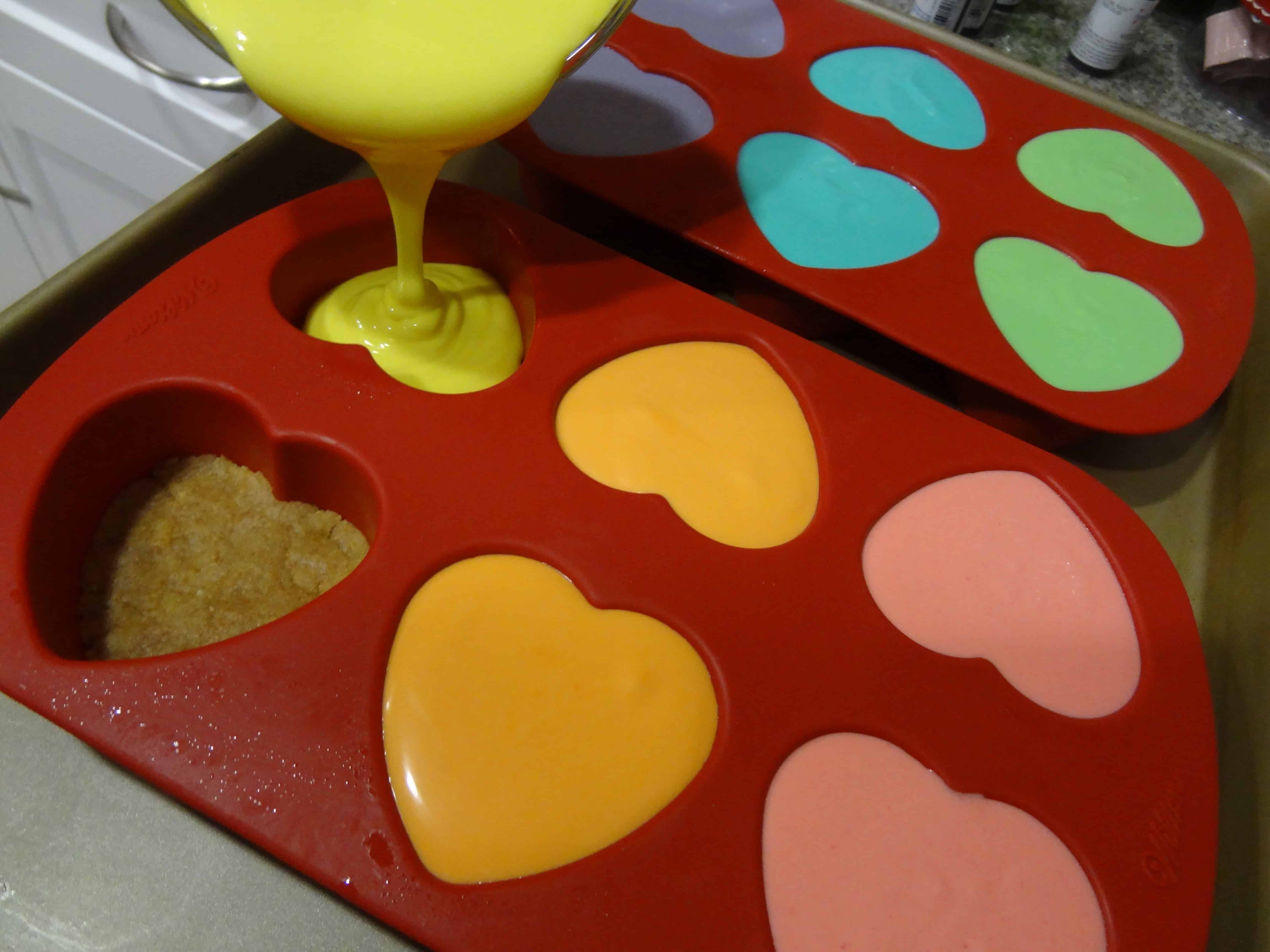
You will bake your cheesecakes in a water bath inside a roasting pan (remember, don’t use a sheet pan!), which you can do in one of the following two ways:
- Place the filled silicone molds side by side in the roasting pan. Pour boiling water (heated in a kettle, for example) very carefully into the roasting pan around the molds, so that it reaches about halfway up the sides of the heart wells.
- If you have a roasting pan with a removable flat rack with handles, you can pour water into the roasting pan ahead of time and put the pan in the oven during preheating; the water will be hot by the time you’re ready to bake. Place the filled heart molds on the rack and lower the whole thing into the roasting pan; this is probably the best way to avoid burns. 🙂
Bake the cheesecakes for about 25-28 minutes. (I took mine out at 26 minutes.) You will know they’re ready when the tops are set, but still slightly jiggly in the middle. They should not have any browning, as the cakes may be dry and overbaked at that point. The cakes will puff up ever so slightly while baking, but once they cool, they should be perfectly level and flush with the top of the silicone pan.
Next comes the part where I almost burned my limbs. I learned that it is extremely difficult and dangerous to try moving a rimmed sheet pan full of scalding water. (Not sure why that was news, but it seemed like a good idea at the time…) But since you won’t be as reckless as me, you will be able to pull your roasting pan out of the oven responsibly without great risk of injury! Slow and steady is key, in order to avoid water sloshing over your beautiful cheesecakes.
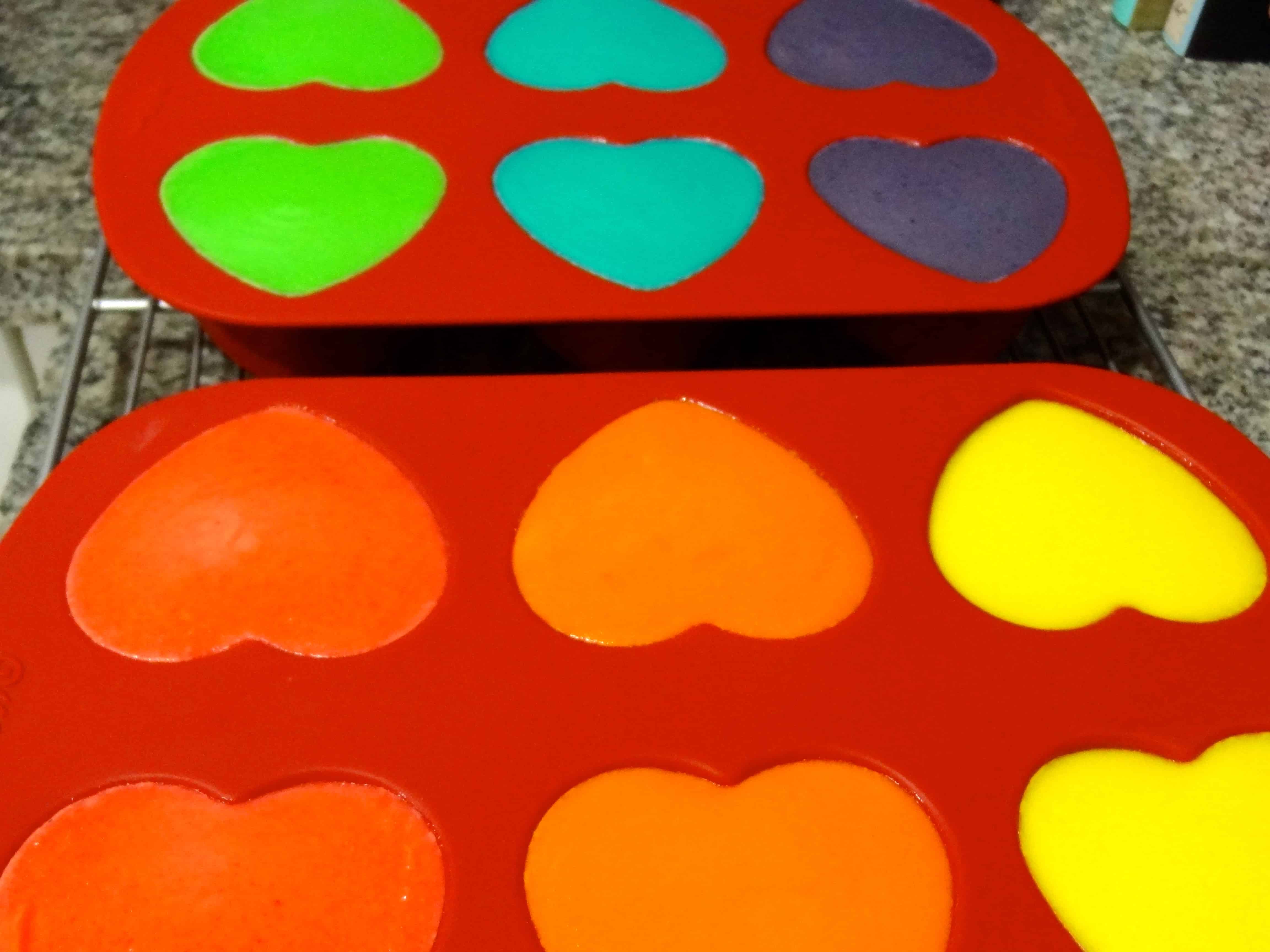
Carefully lift the silicone molds out of the water bath and place on a wire rack to cool. (Again, this is easier if you have one o’ them nifty removable racks with handles.) Allow the cakes to rest for about an hour, or until cooled to room temperature. When they come out of the oven, they will still be rather soft, but will firm up as they cool. Cover the cheesecakes to prevent the tops from drying out and place the silicone pans in the fridge for several hours or overnight to chill. I covered mine with 2 inverted 6-well cupcake pans, rather than plastic wrap; this kept condensation on the cheesecake surface to a minimum. (You can probably use a regular 12-well cupcake pan just as easily if you push the silicone molds together.)
Transfer the molds to the freezer (uncovered) for about 90 minutes right before you’re ready to remove and decorate the cakes.
The frozen cakes are much easier to remove from the molds, though still a bit of a challenge. After trying to “peel” down the silicone from each cake (and almost destroying a couple in the process), I wondered if I could pop them out by pushing straight up from the bottom. By applying firm, yet gentle, pressure on the bottom of each well, I was able to push them up enough to get a finger under the crust, and pull up from there.
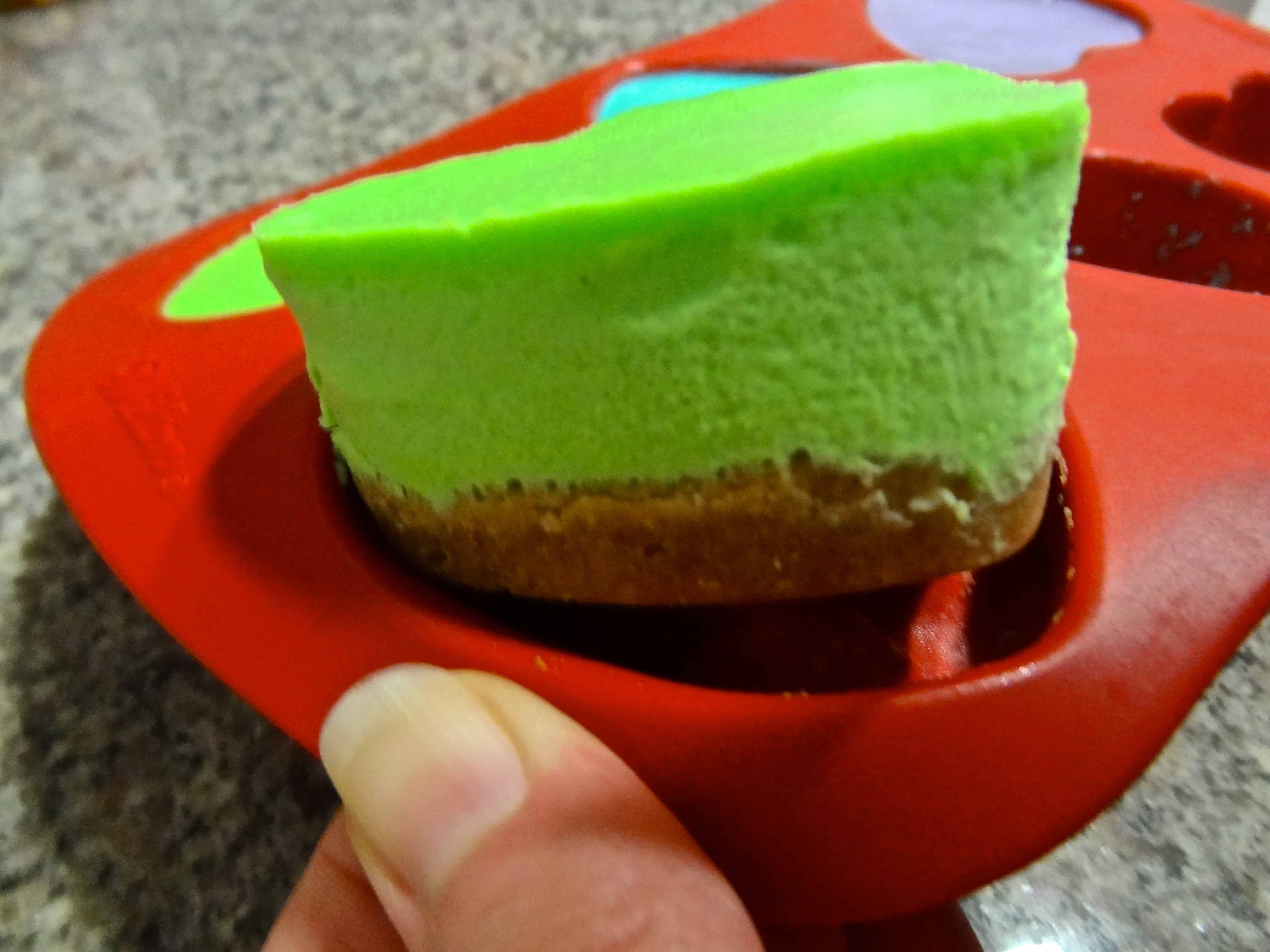

Basically, I focused on three “pressure points”: both rounded lobes at the top of the heart, and the bottom point of the heart. You will feel a slight “pop” when the crust releases from the silicone, at which point you will be able to slowly start pushing the cake up and out. I only had a couple of broken crust pieces as I figured out this method, and all the cakes came out intact once I was doing this systematically.
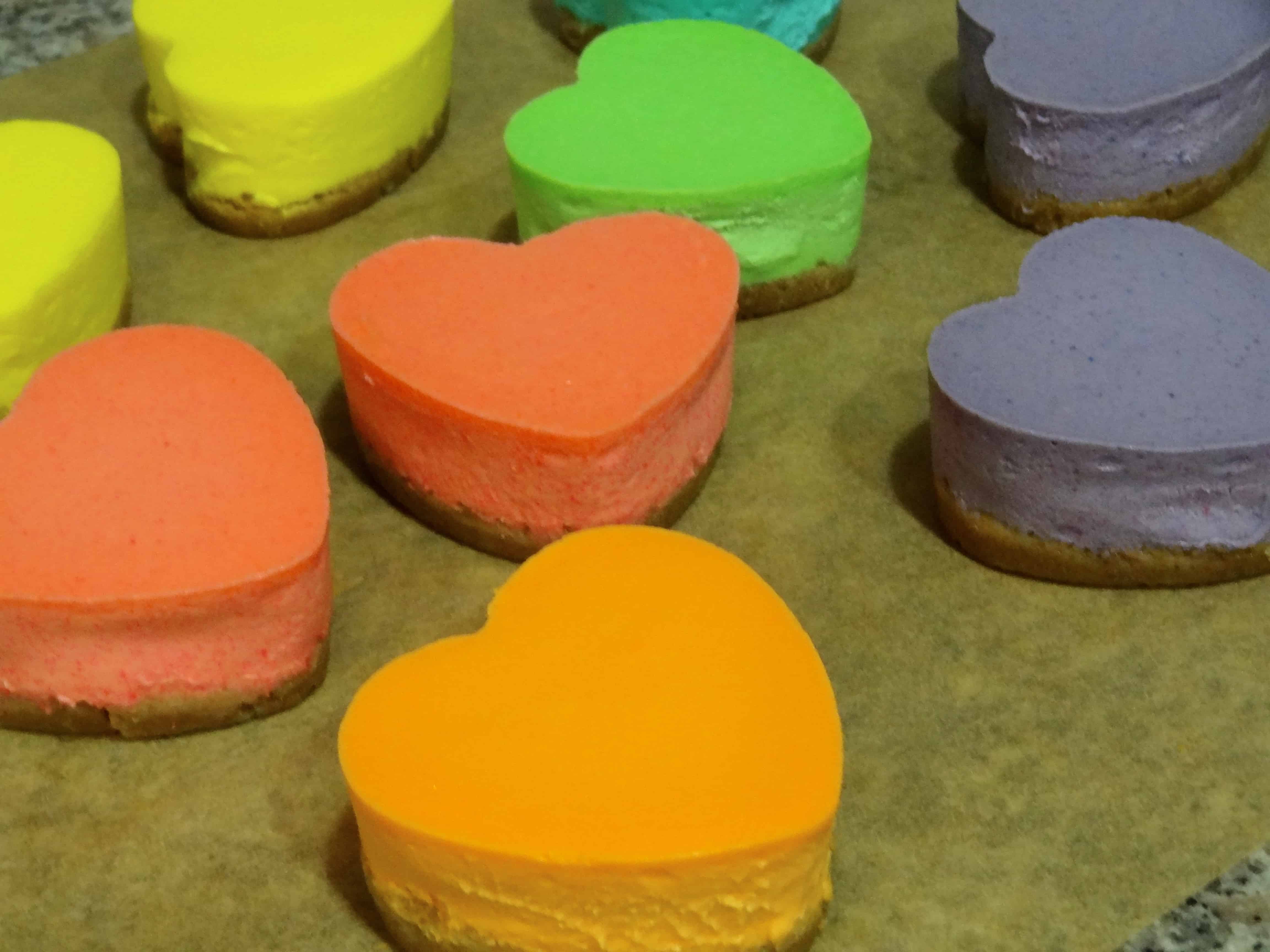
The last step is adding your sweet love messages to the tops of your cheesecake hearts. Squeeze about 4 drops of red gel food coloring into a small bowl. Using your fine-tipped paintbrush, paint conversation heart phrases onto each cake. This requires a steady hand and takes a bit of practice! Carefully write your sayings in red capital letters, just like the candies. (You may want to practice a few on parchment paper first to get the hang of it– sloppy letters look like you’re writing with blood!)
During this process, your cheesecakes may have warmed up quite a bit, depending on how long your painting process took; I recommend putting them back in the fridge for 30-60 minutes to re-chill if you prefer them cold. (This also allows the food coloring to dry before you dive into the deliciousness.) Serve the cheesecakes cold or at room temperature. They will keep refrigerated for a few days.
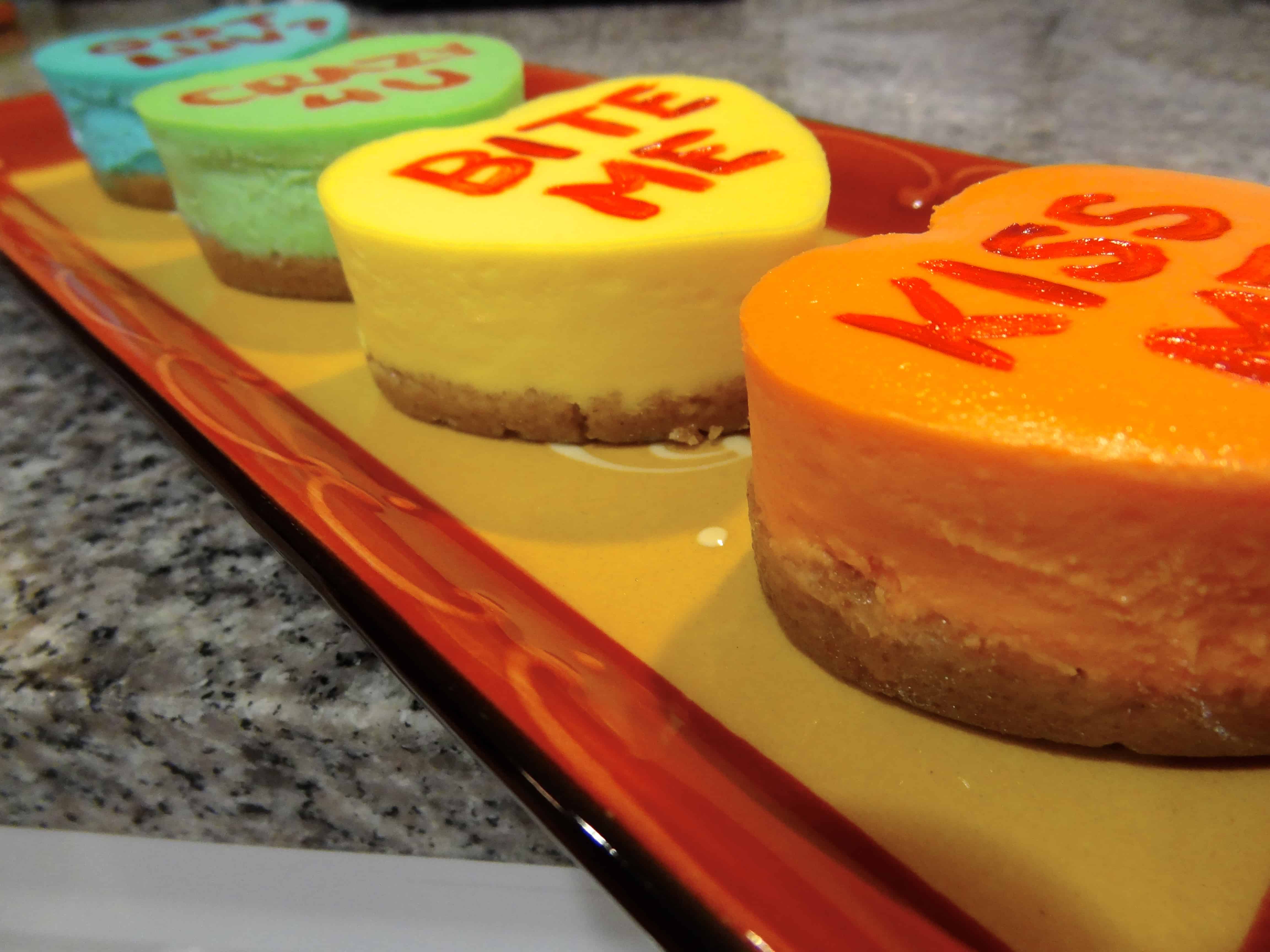
MAKE AHEAD: You can make the graham crust up to several days ahead. Press the crumbs into the silicone molds, cover, and chill in the fridge (or even freeze for a month) until ready to use.
VARIATIONS: This cheesecake recipe is very versatile. You can make one full-sized cheesecake in a standard springform pan (as in the original recipe). You will use the entire batch of graham crust– bake at 350°F for 5-10 minutes prior to filling with the cheesecake batter.
Additionally, you can flavor this recipe with all sorts of mix-ins, including Oreo crumbs (substitute Oreo crust– YUM), fruit purées or chunks, fresh mint, cinnamon, chocolate, caramel, etc.– the possibilities are vast and tasty!
I hope you enjoy these little Valentine’s treasures– I feel like they are a unique treat to show your special someone how much you care. And if you don’t have that special person in your life this Valentine’s Day, there’s always this… 😉
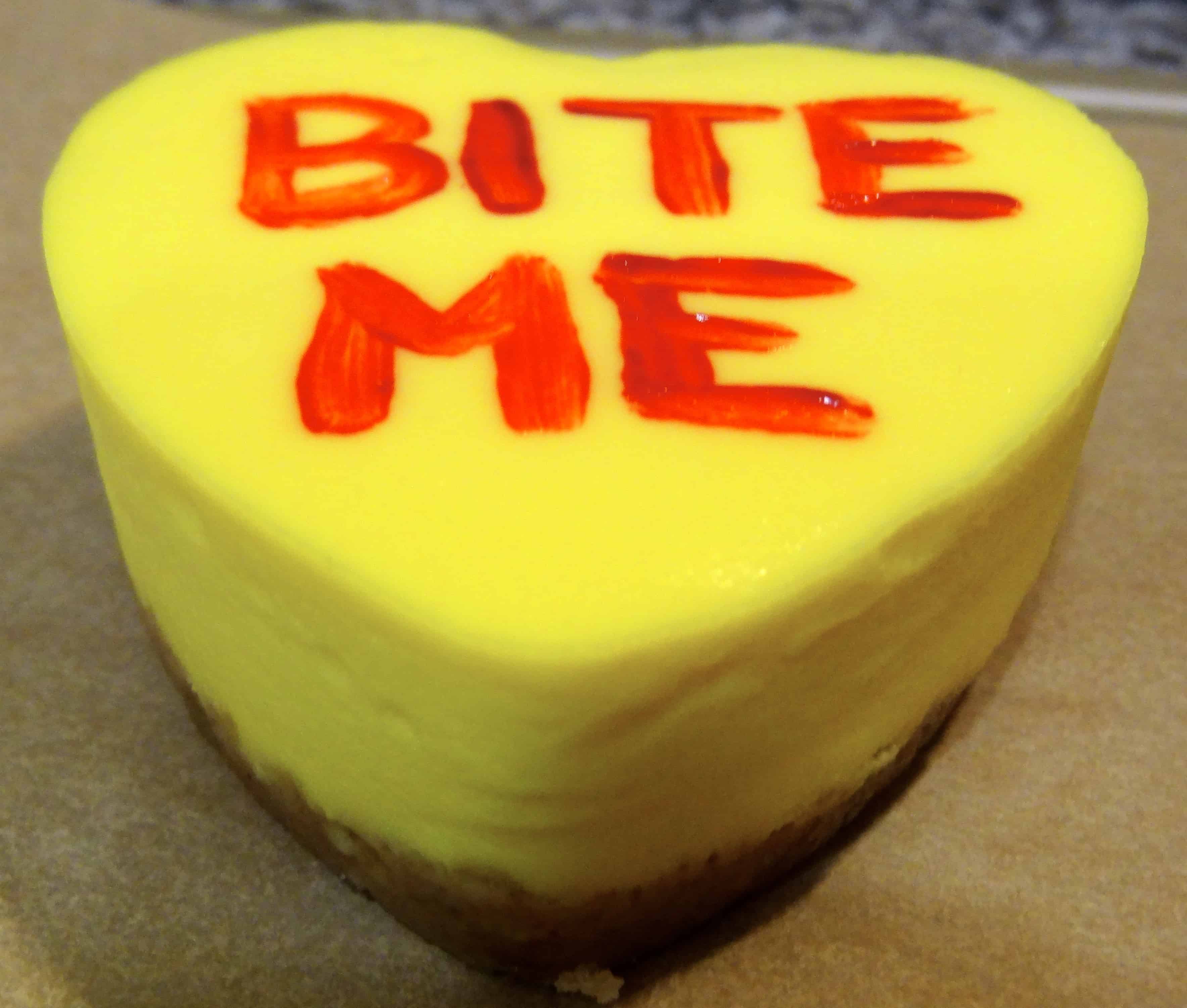
© Dafna Adler & Stellina Sweets, 2013.


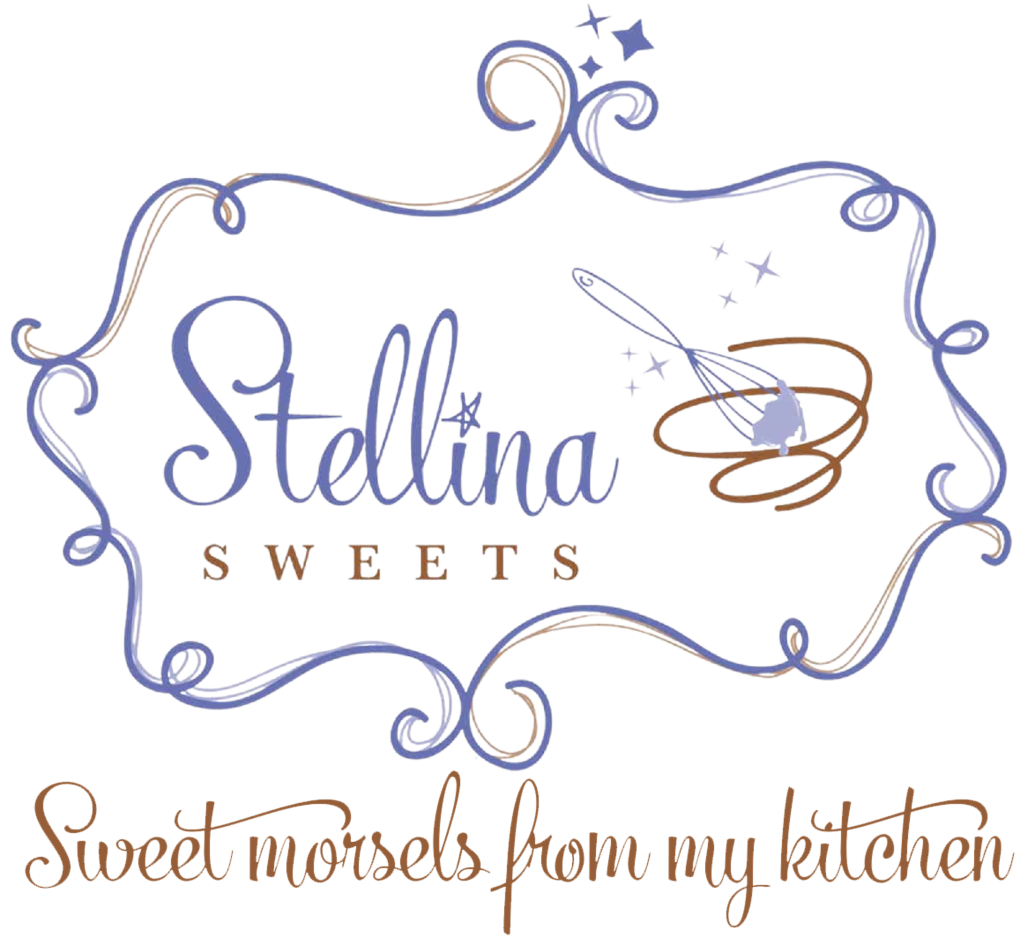

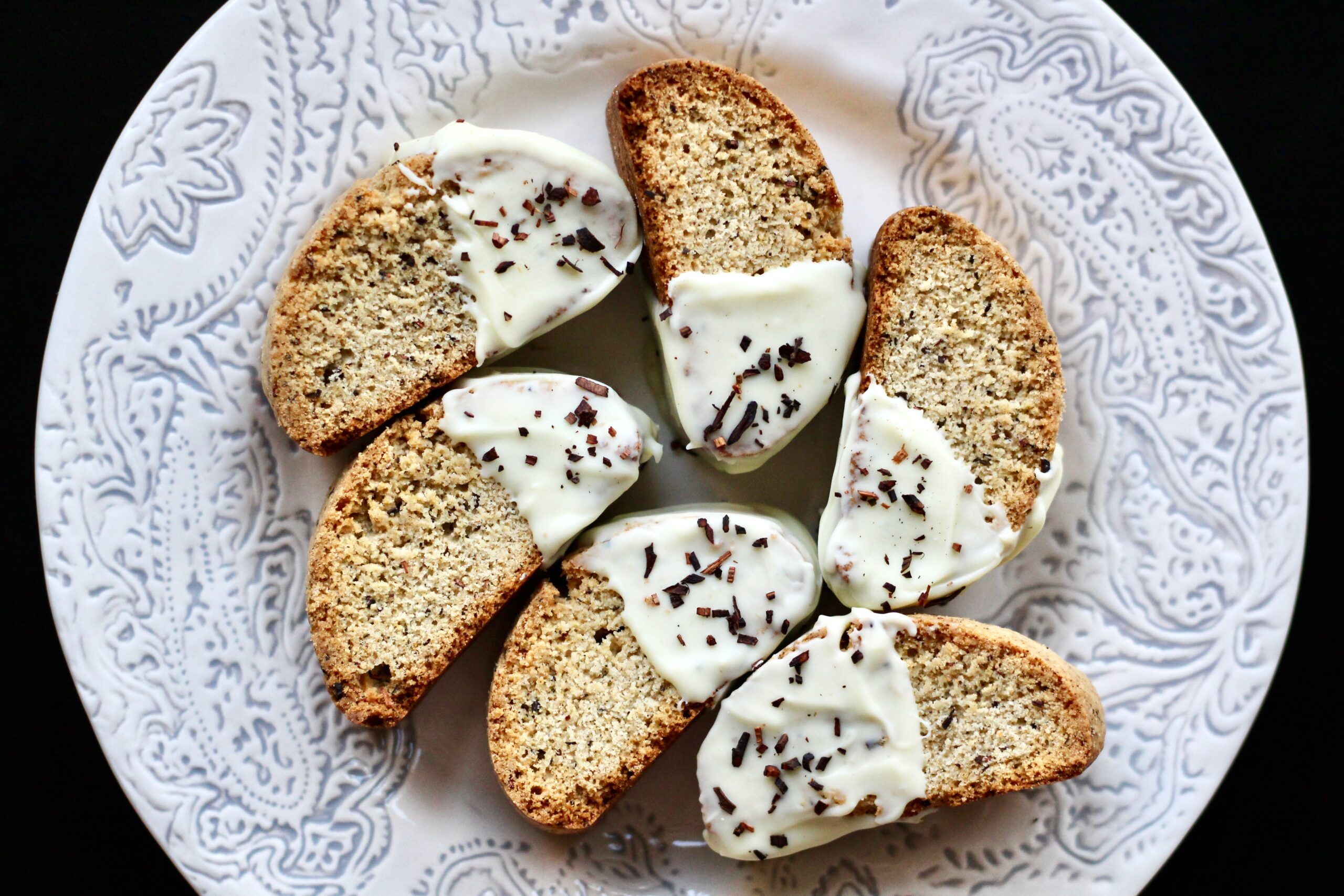
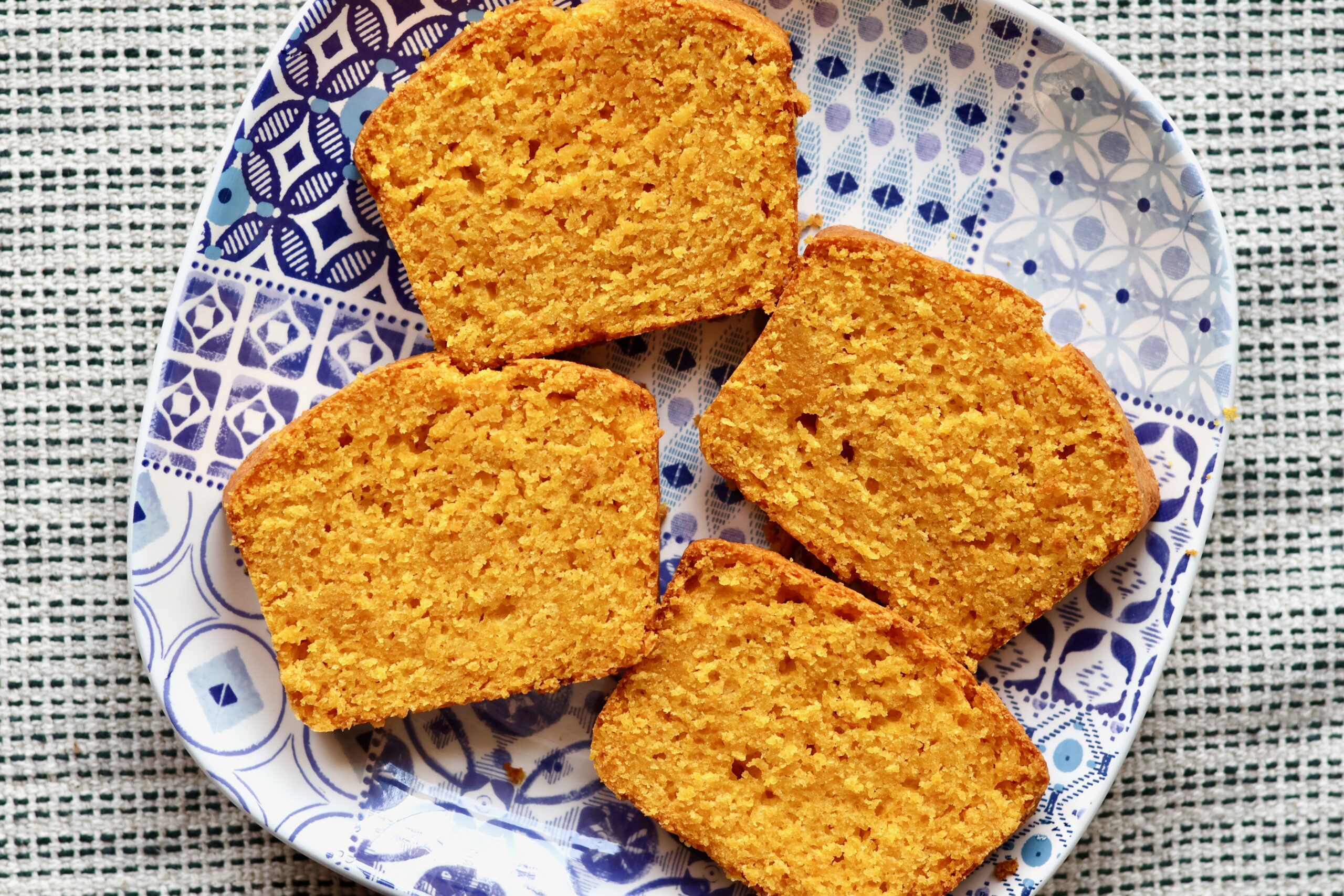
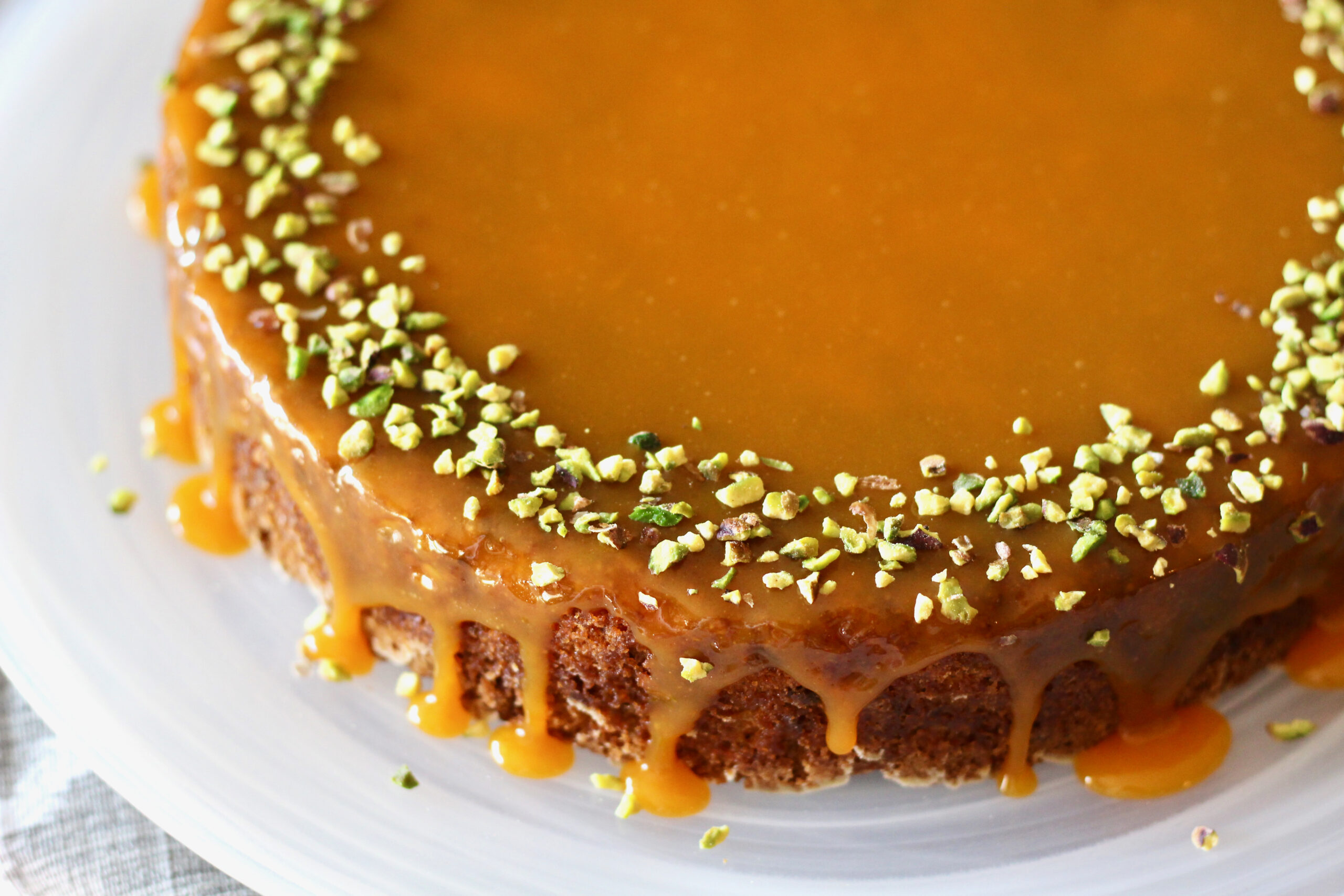
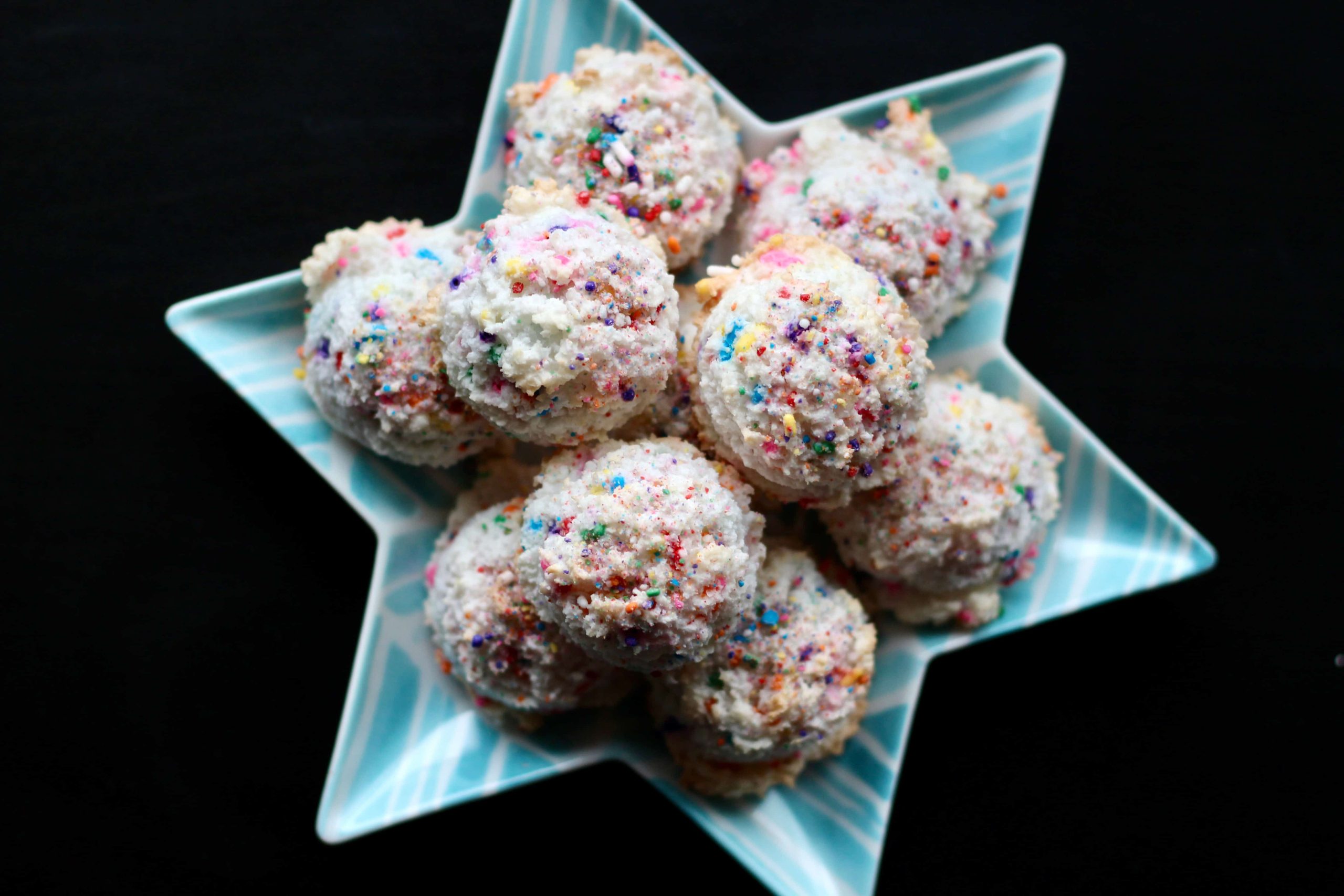
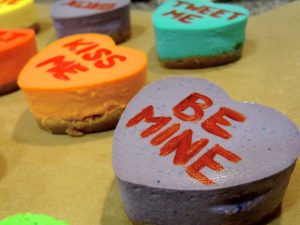

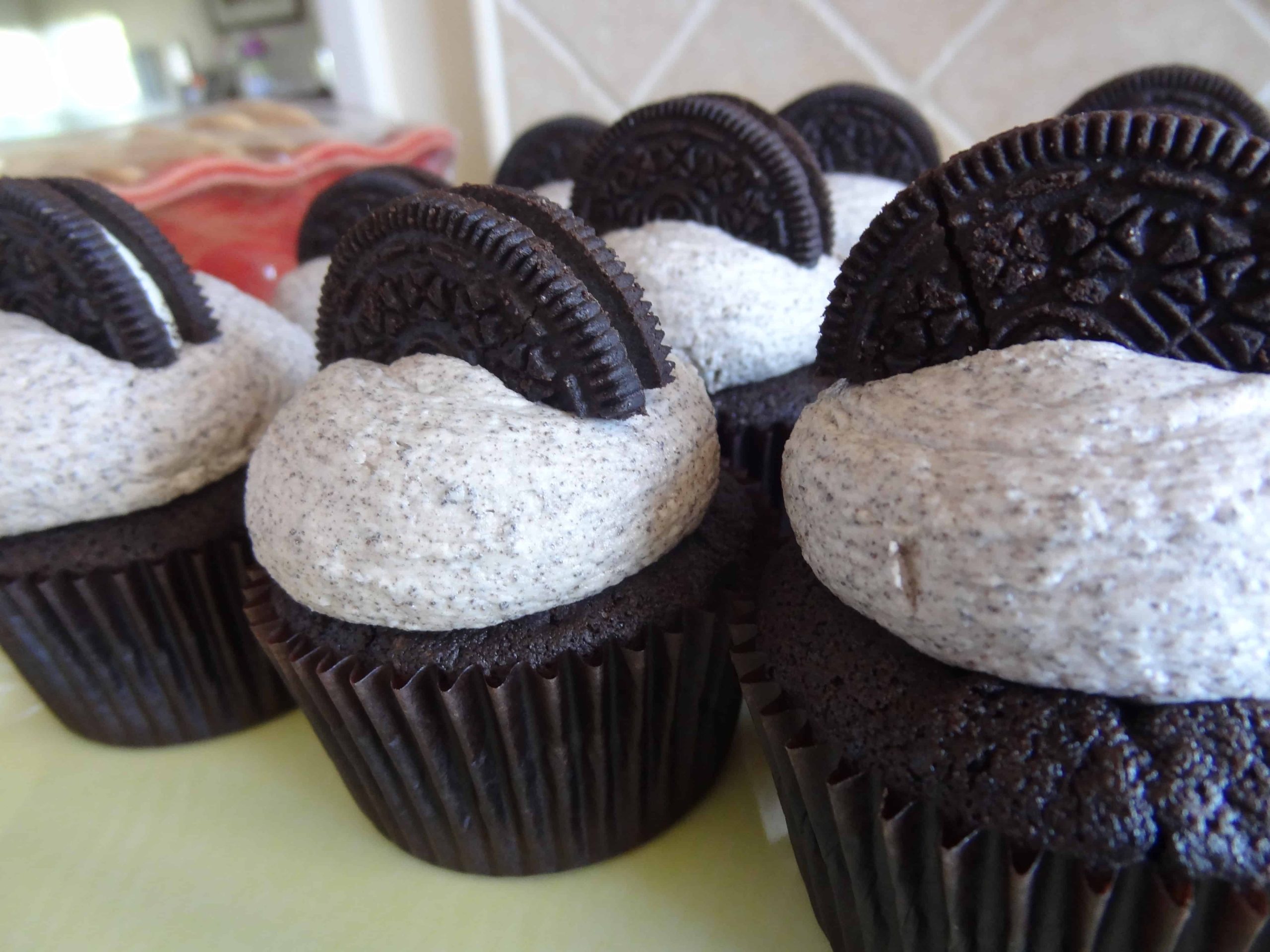

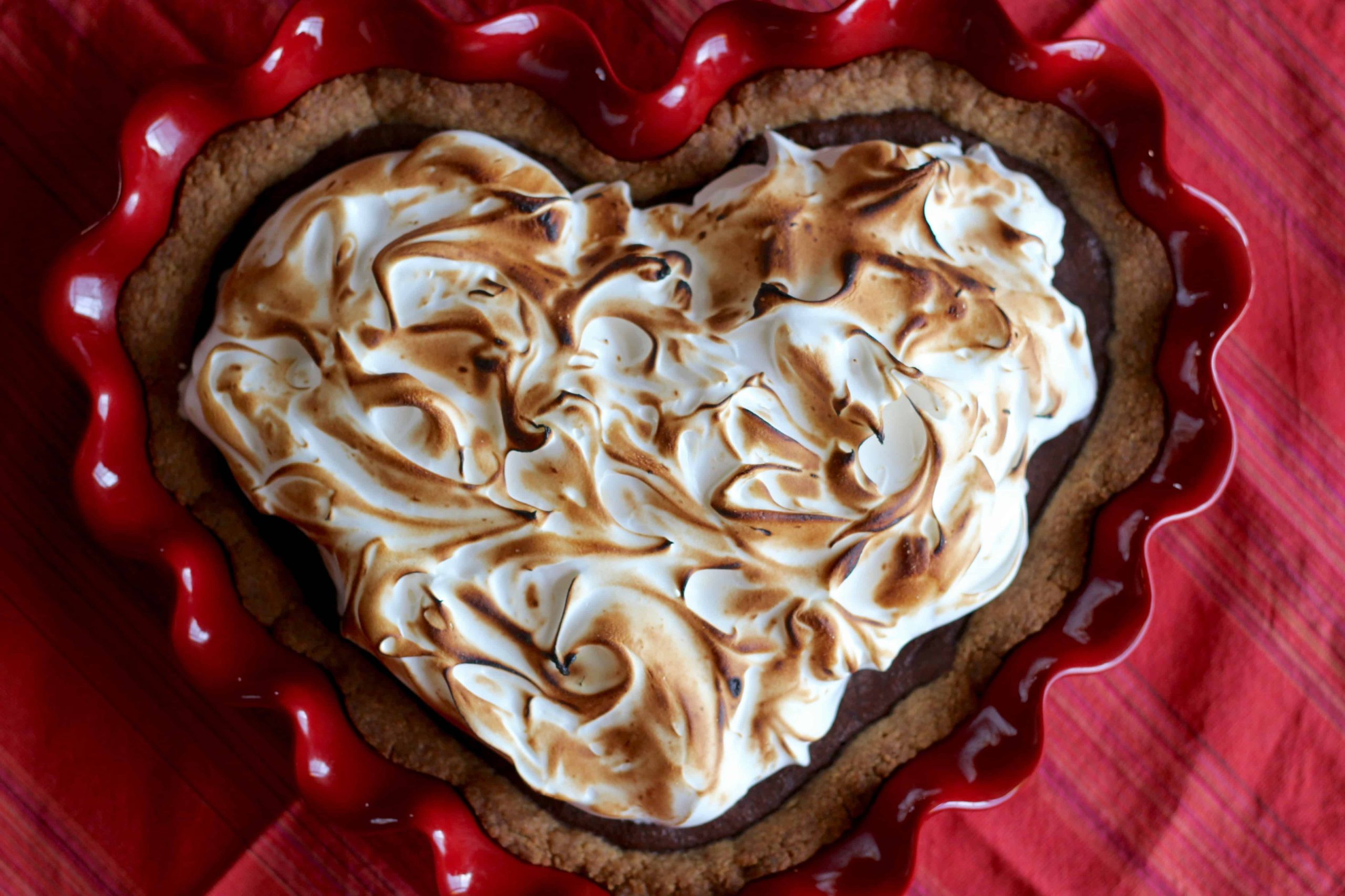
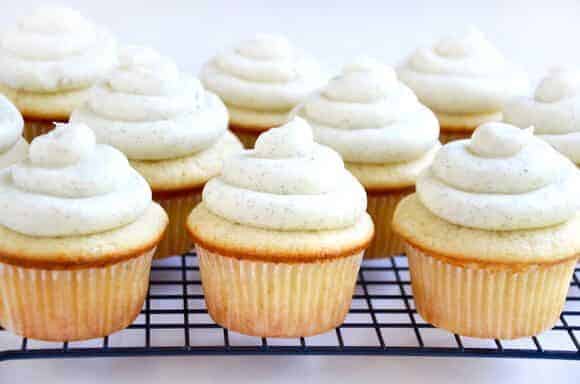
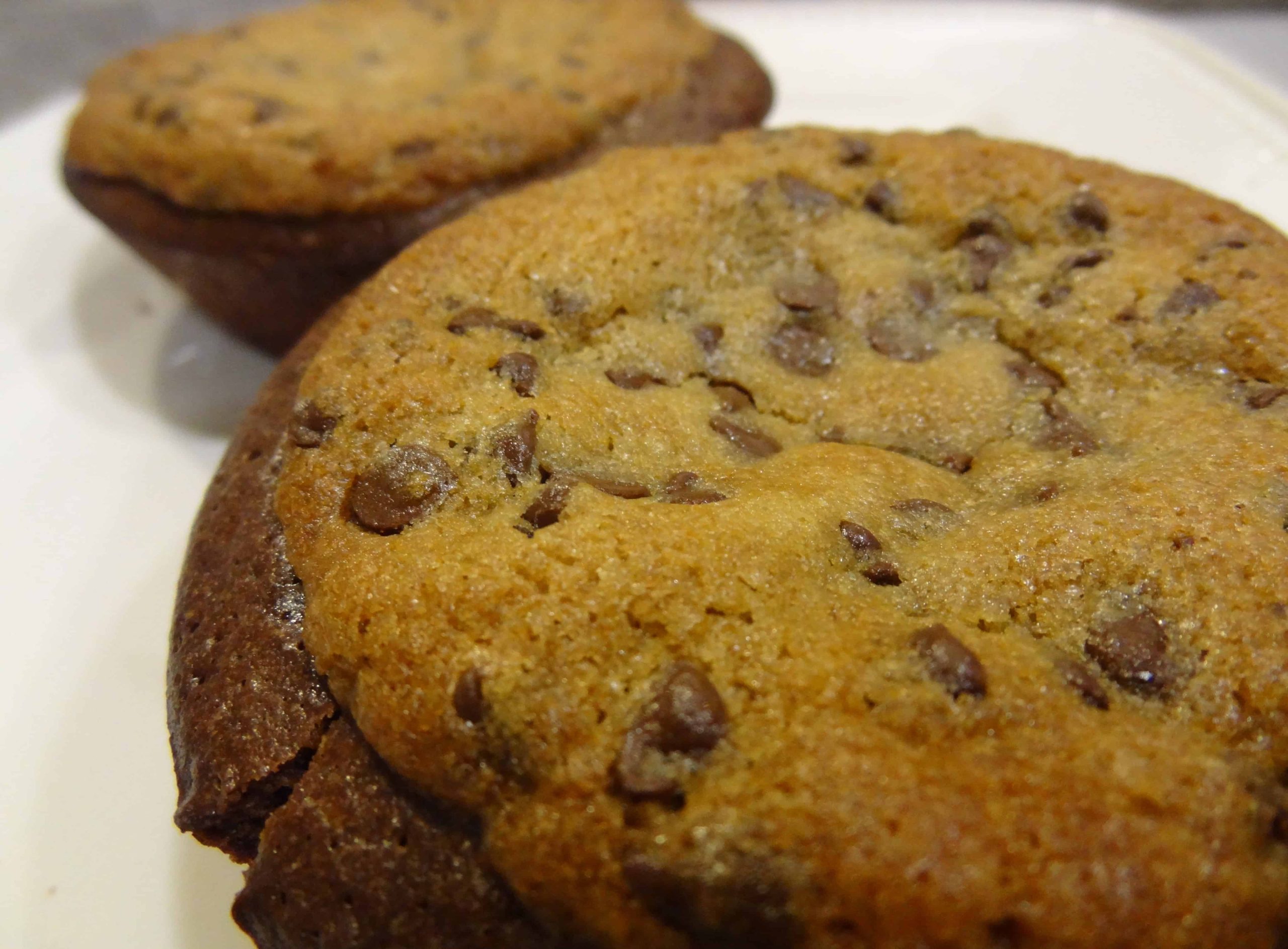
2 Responses